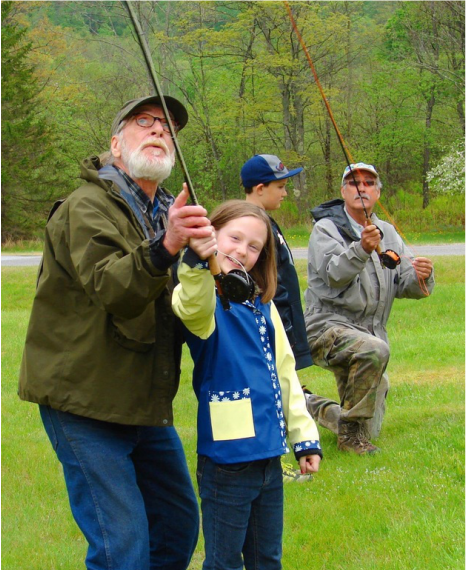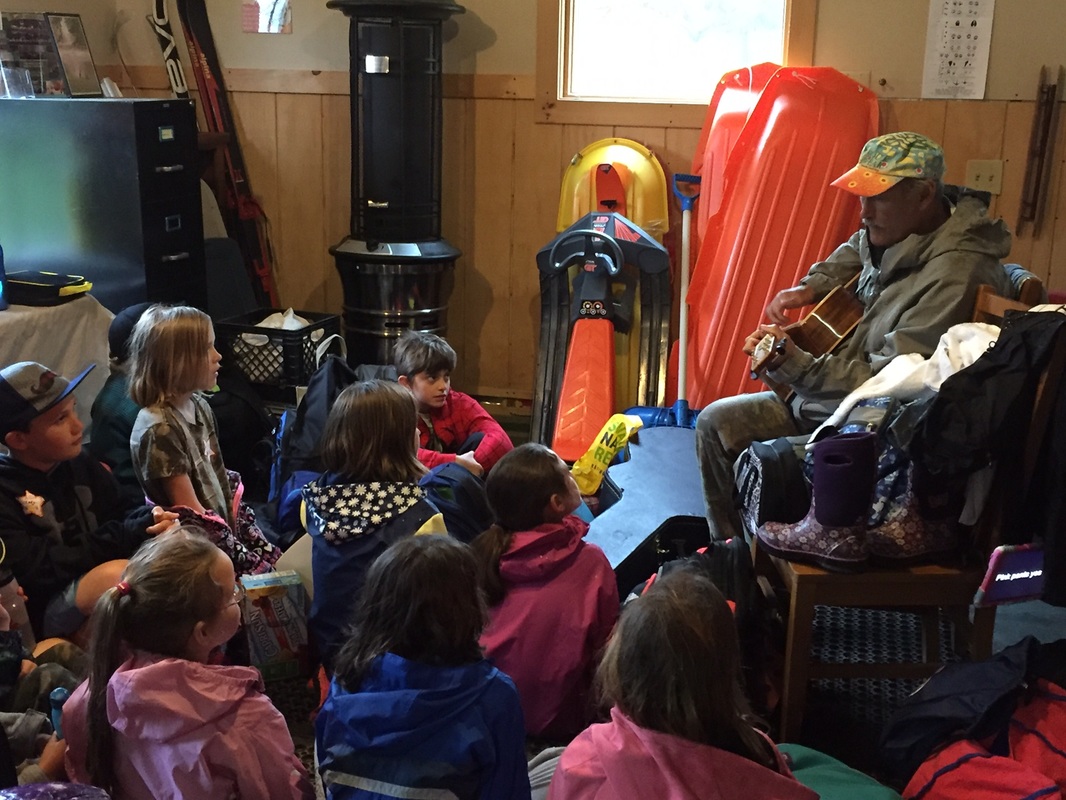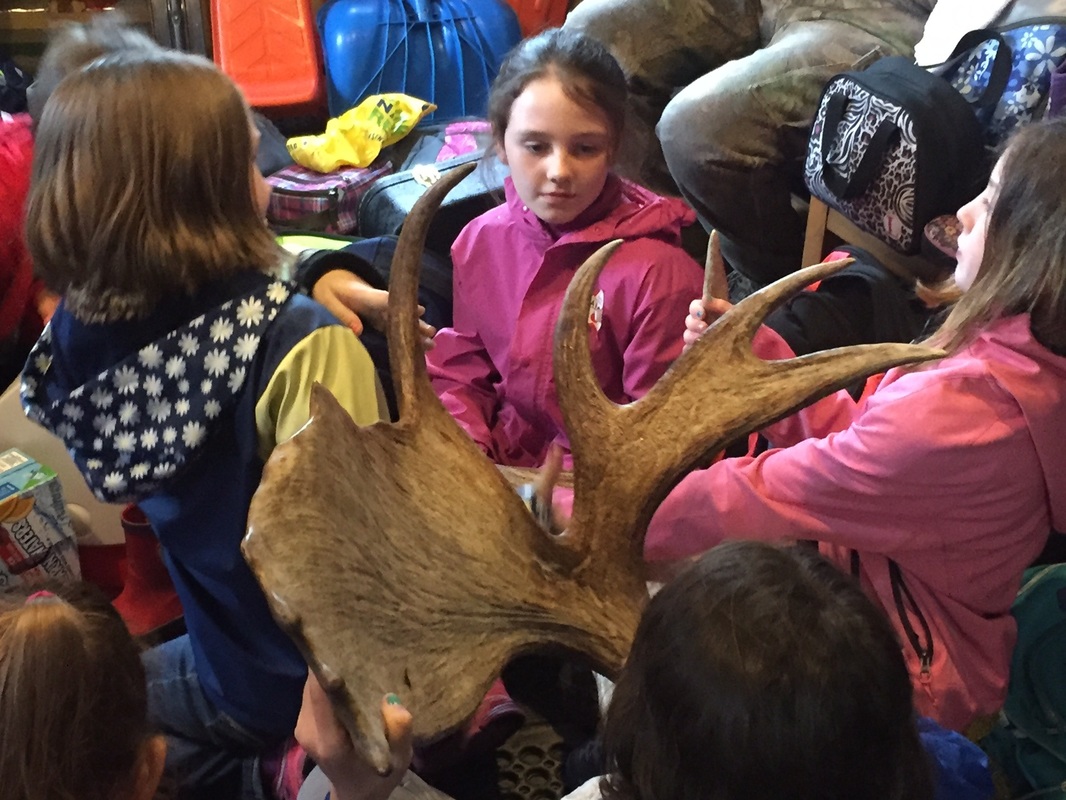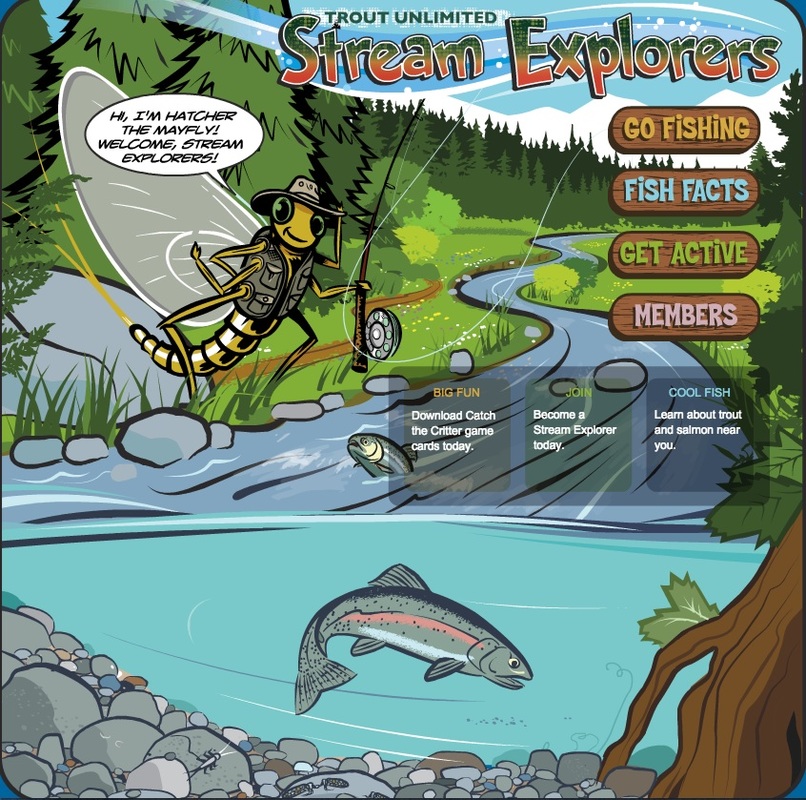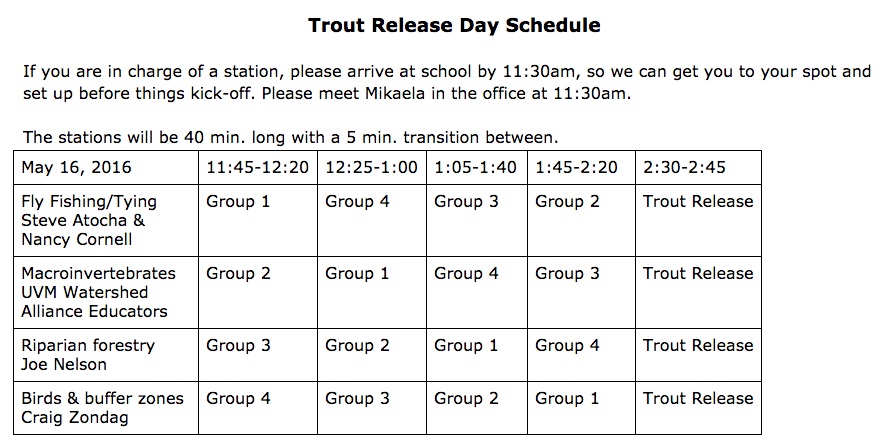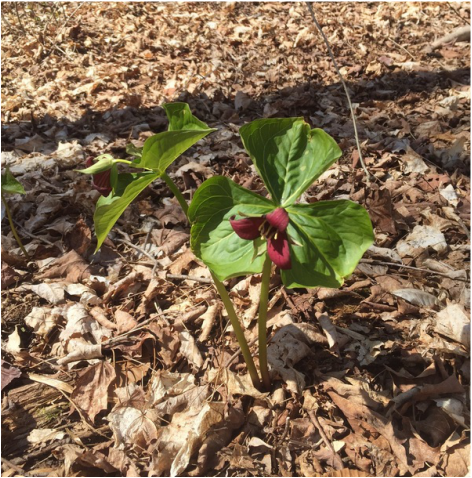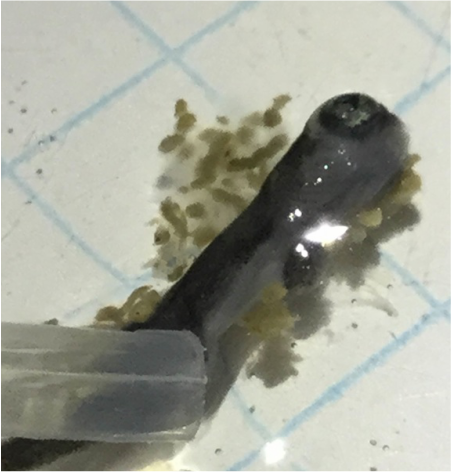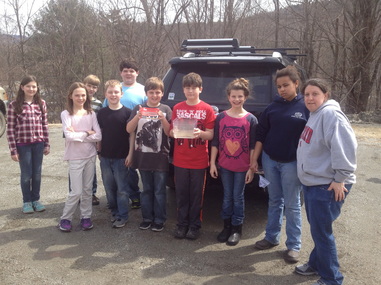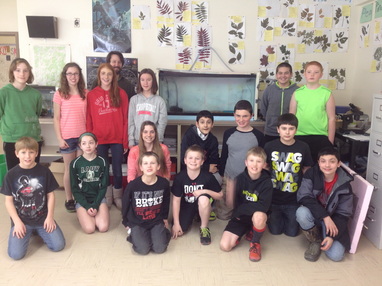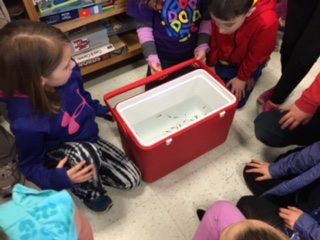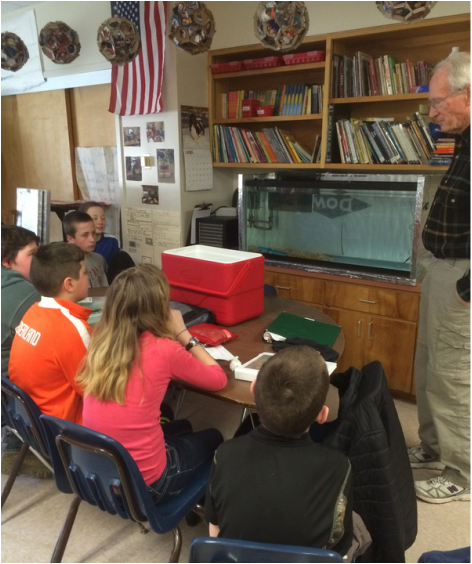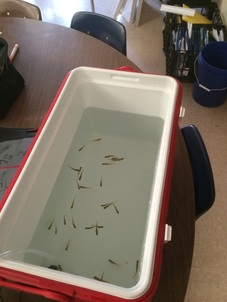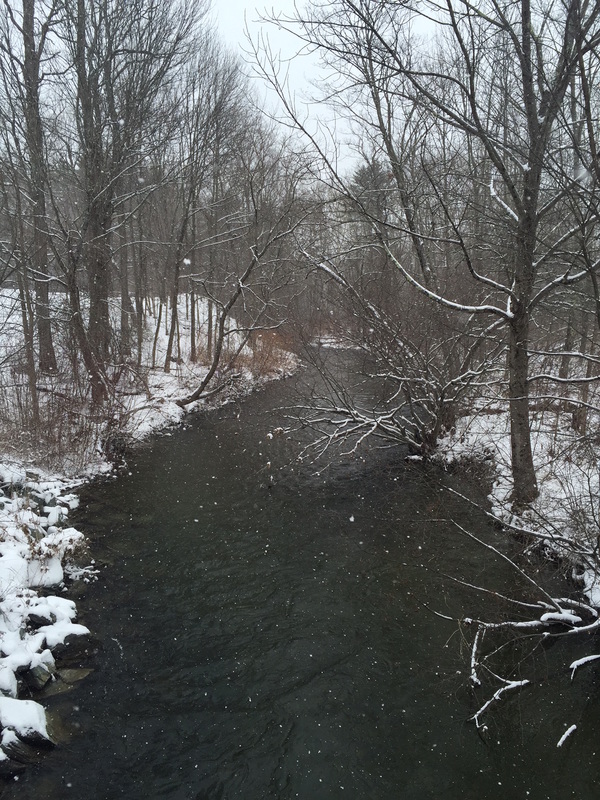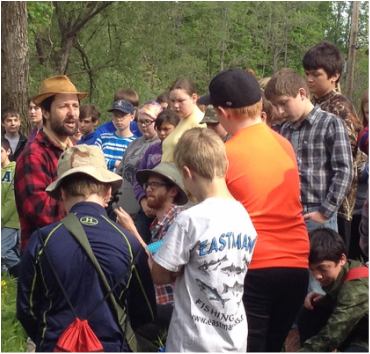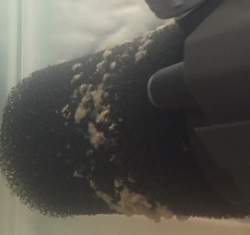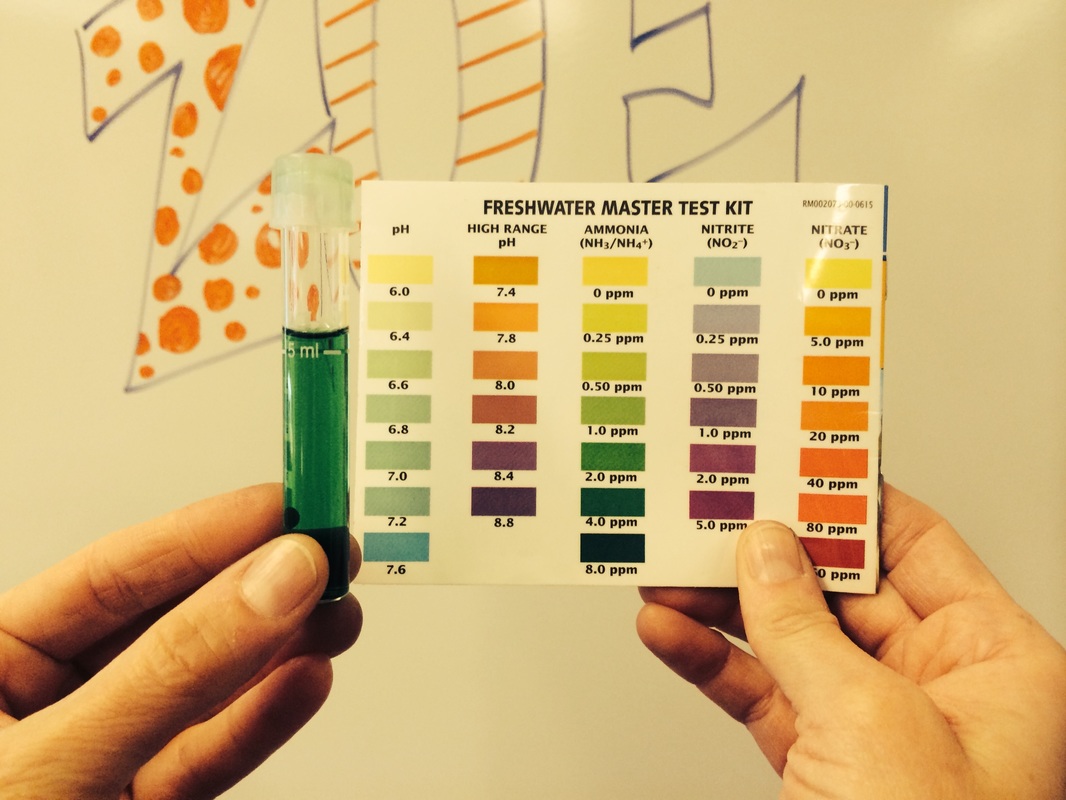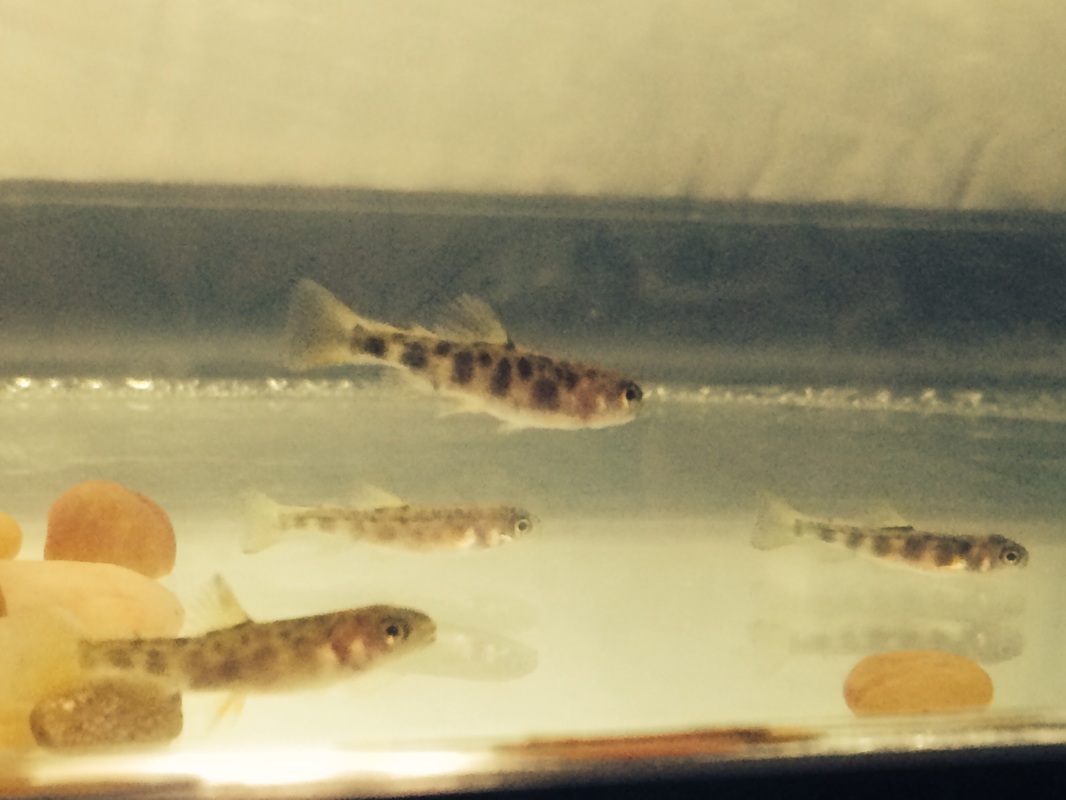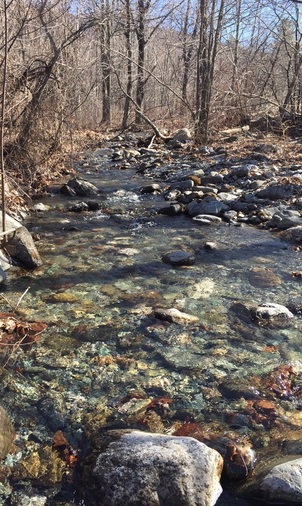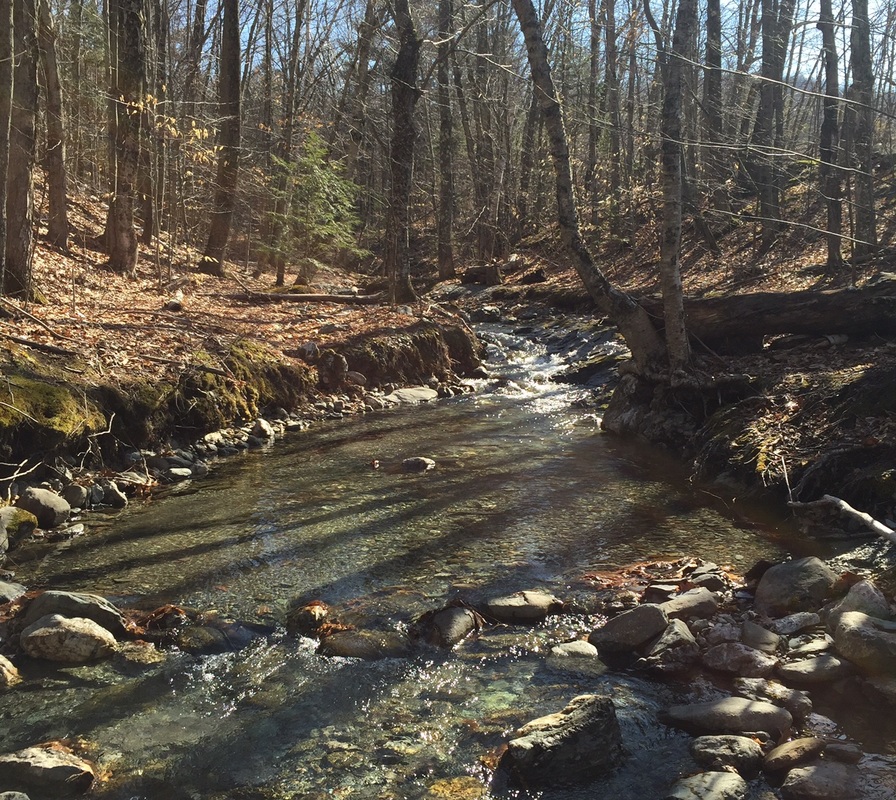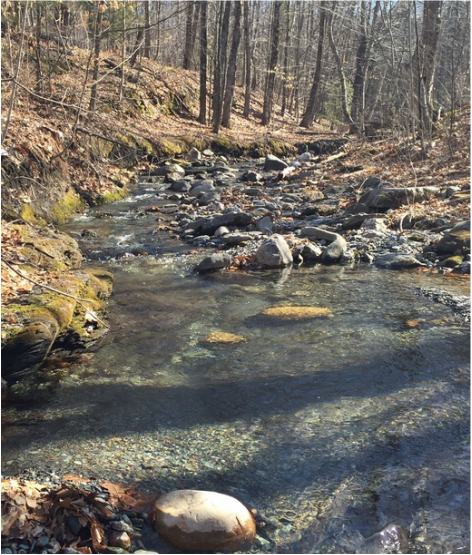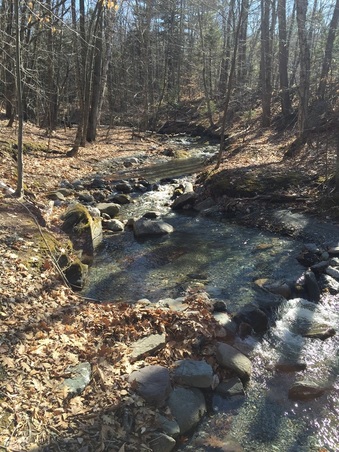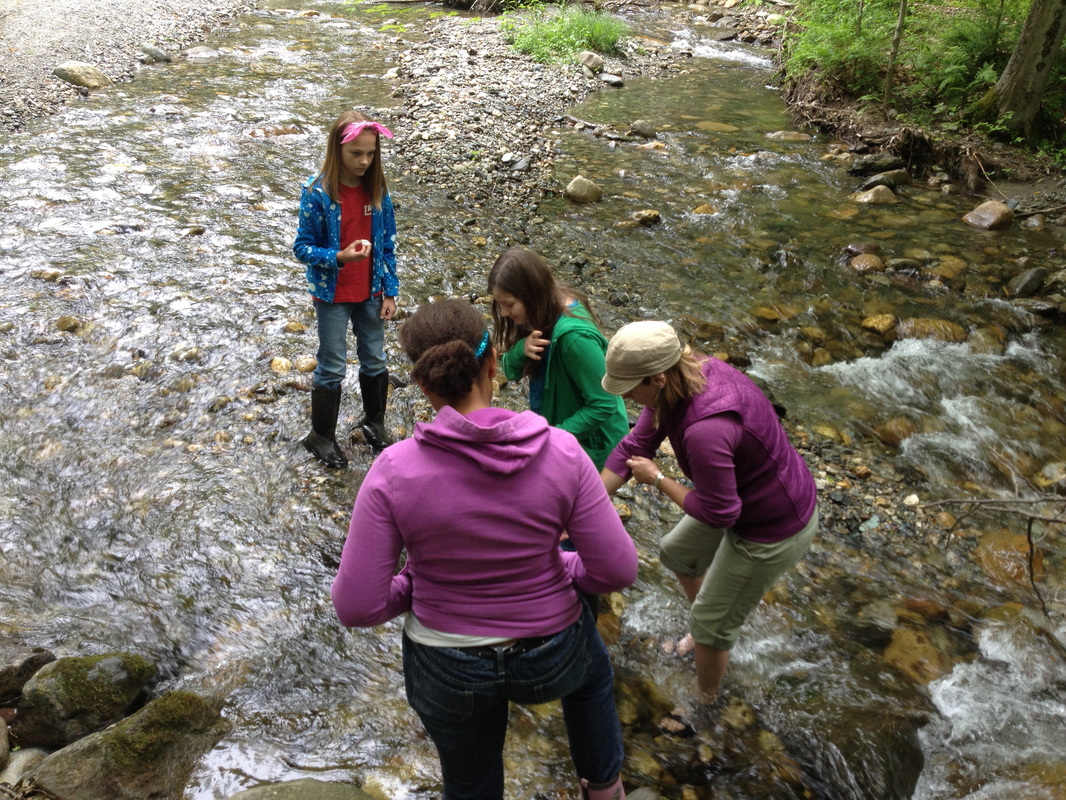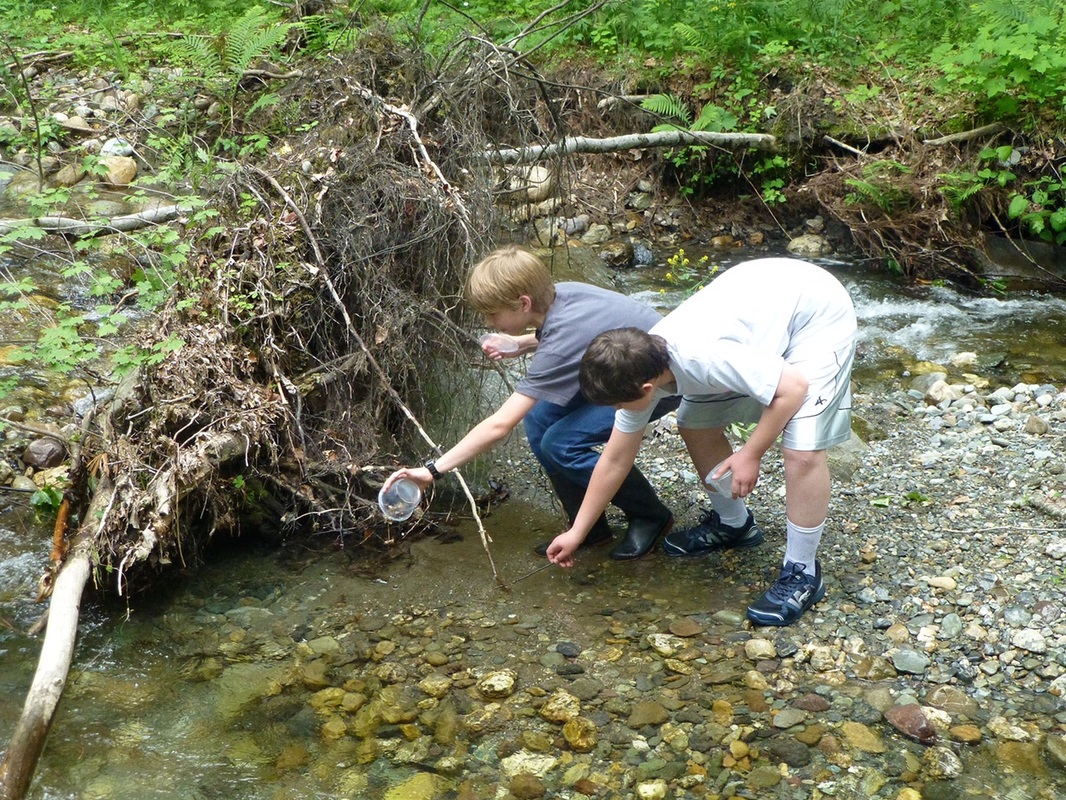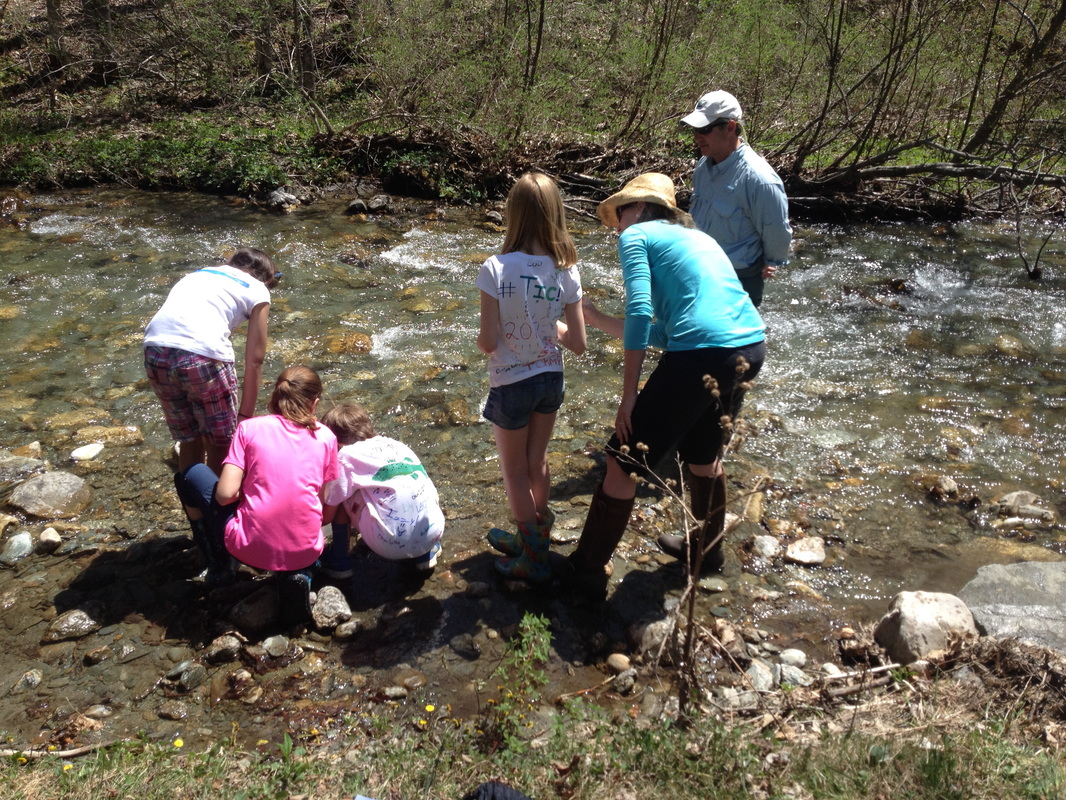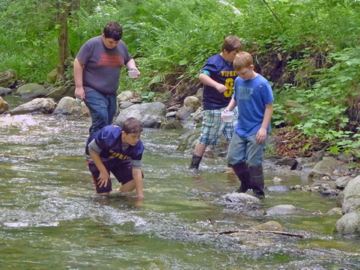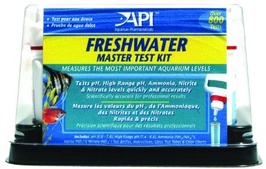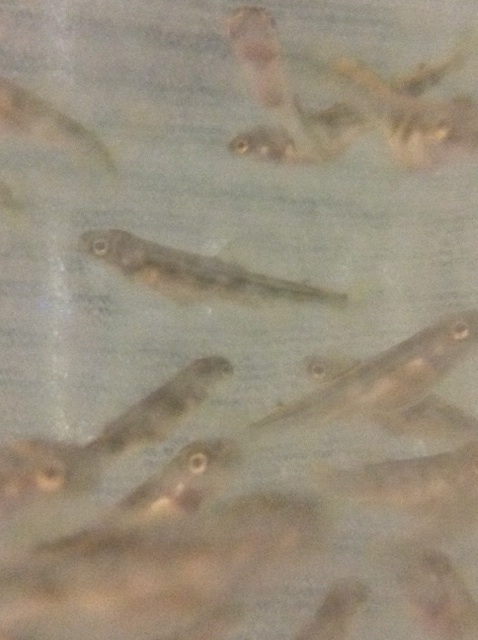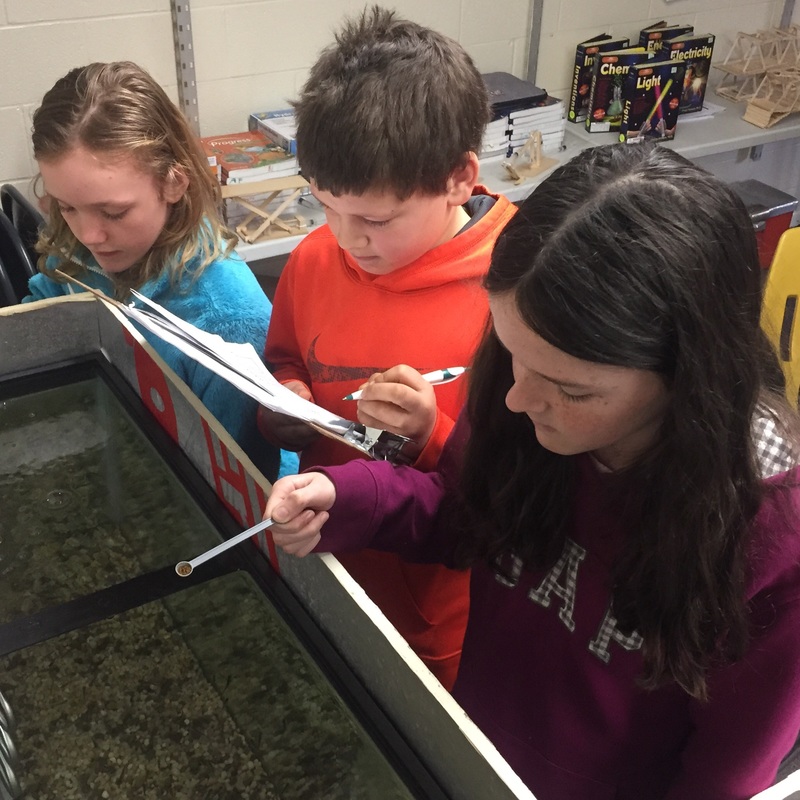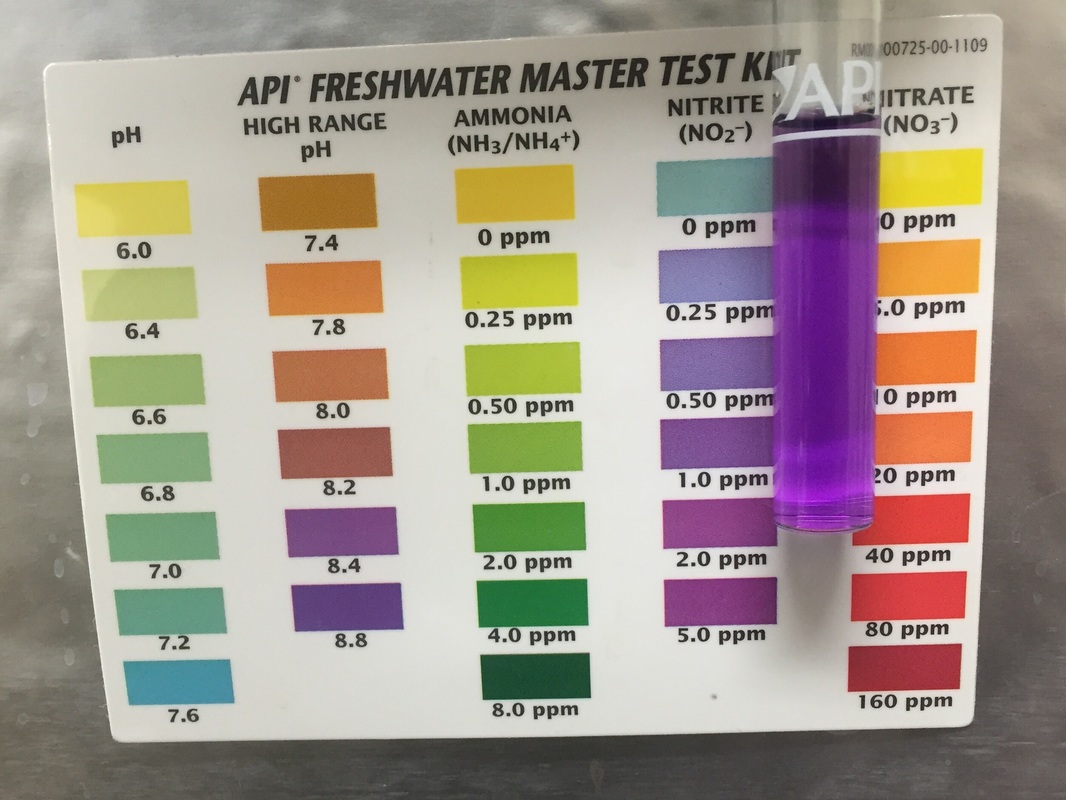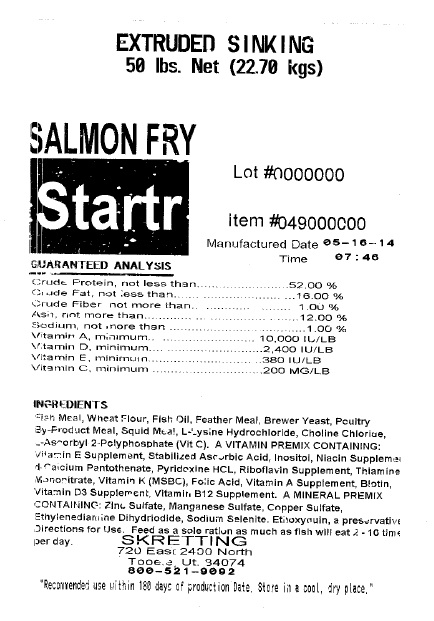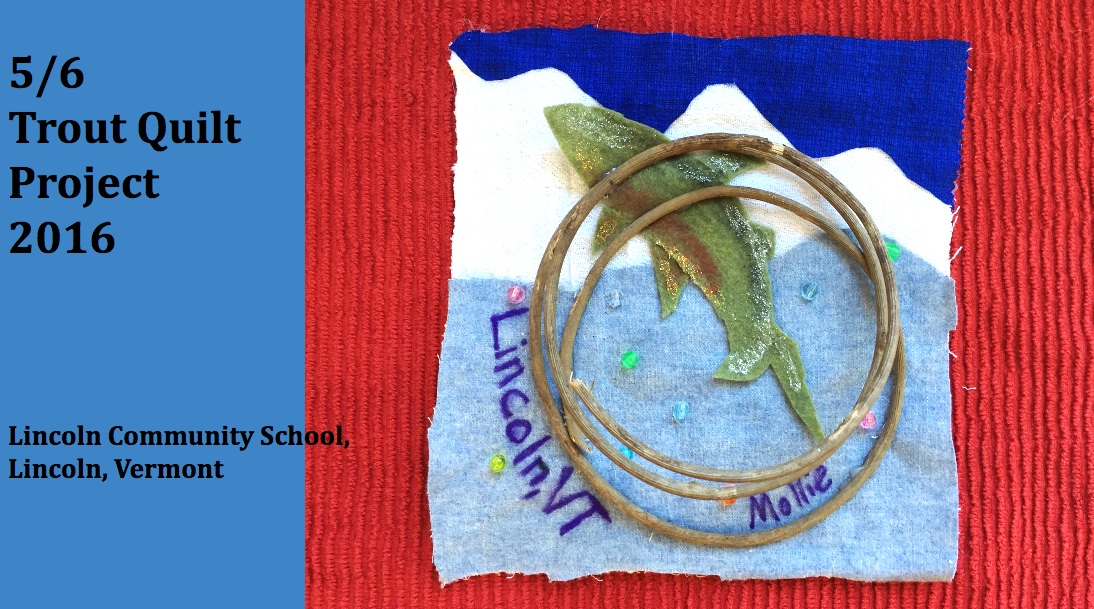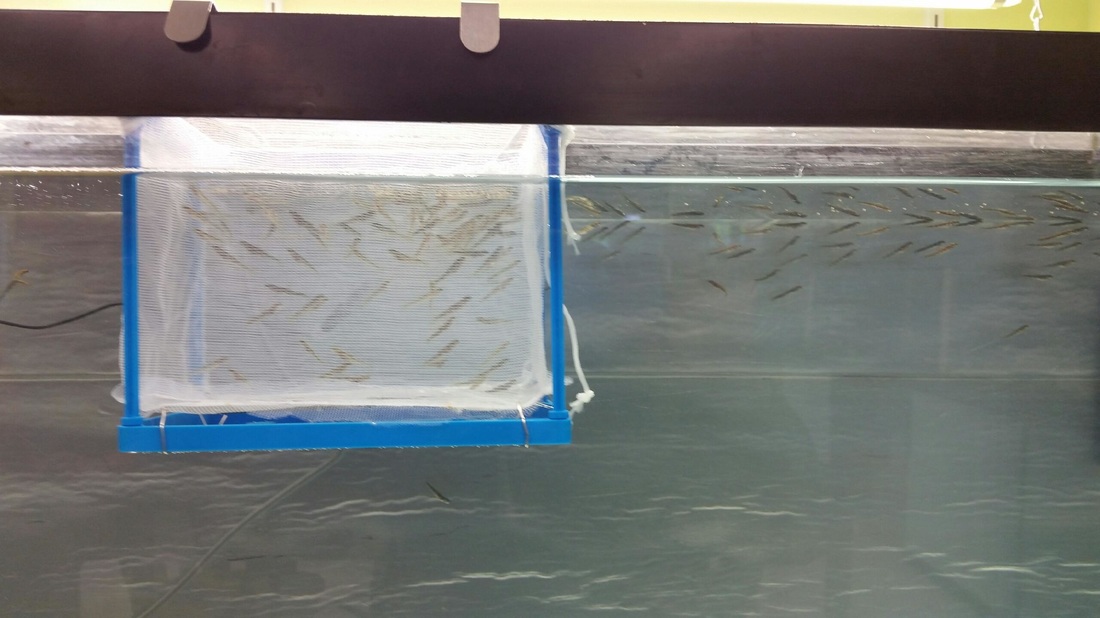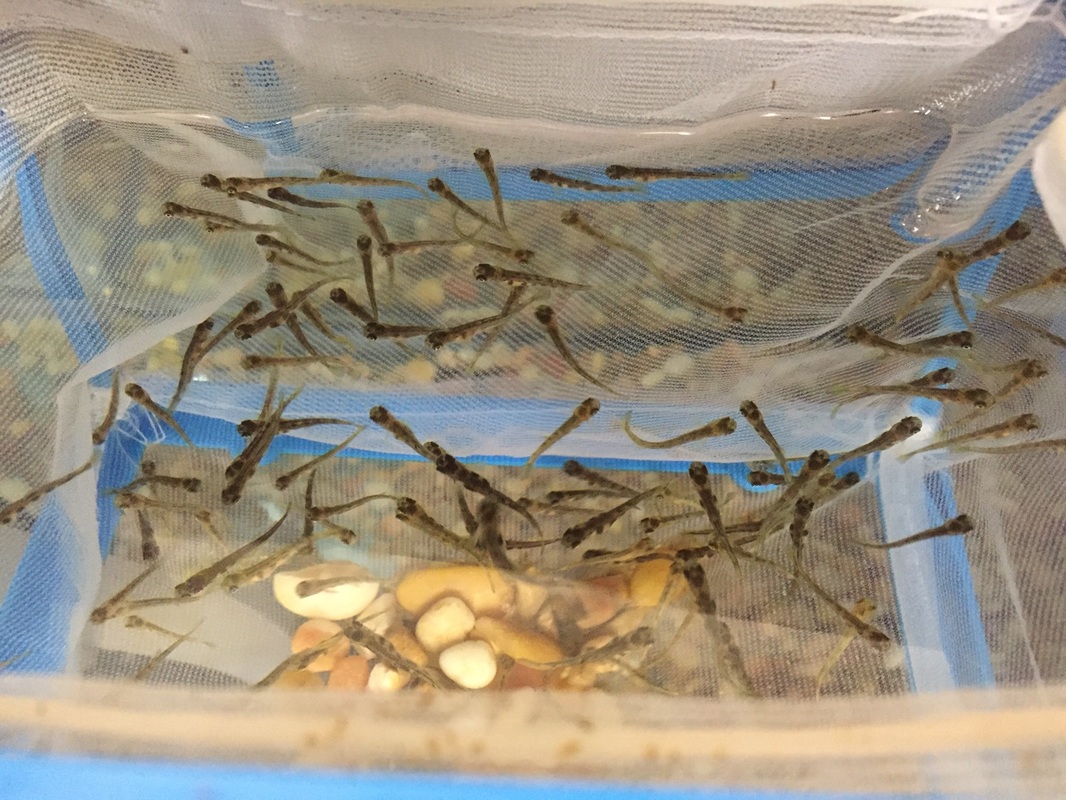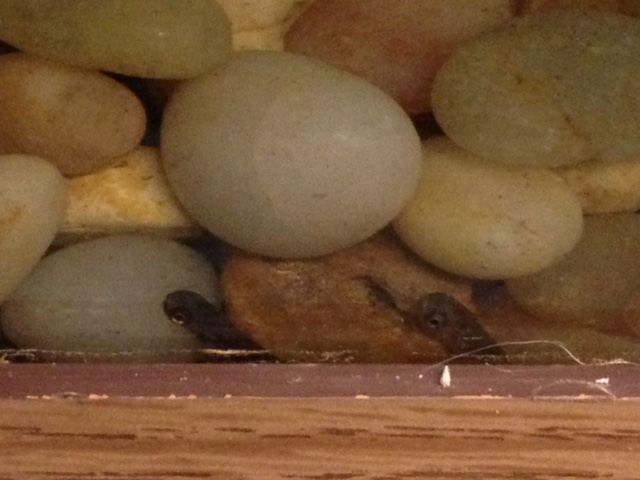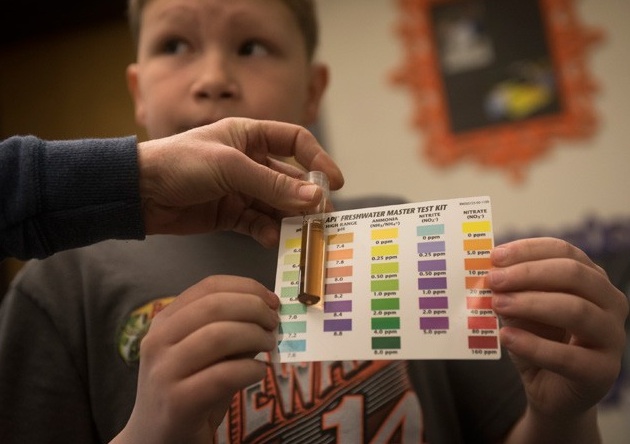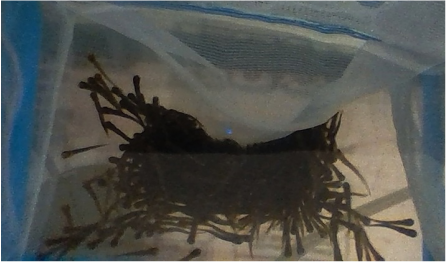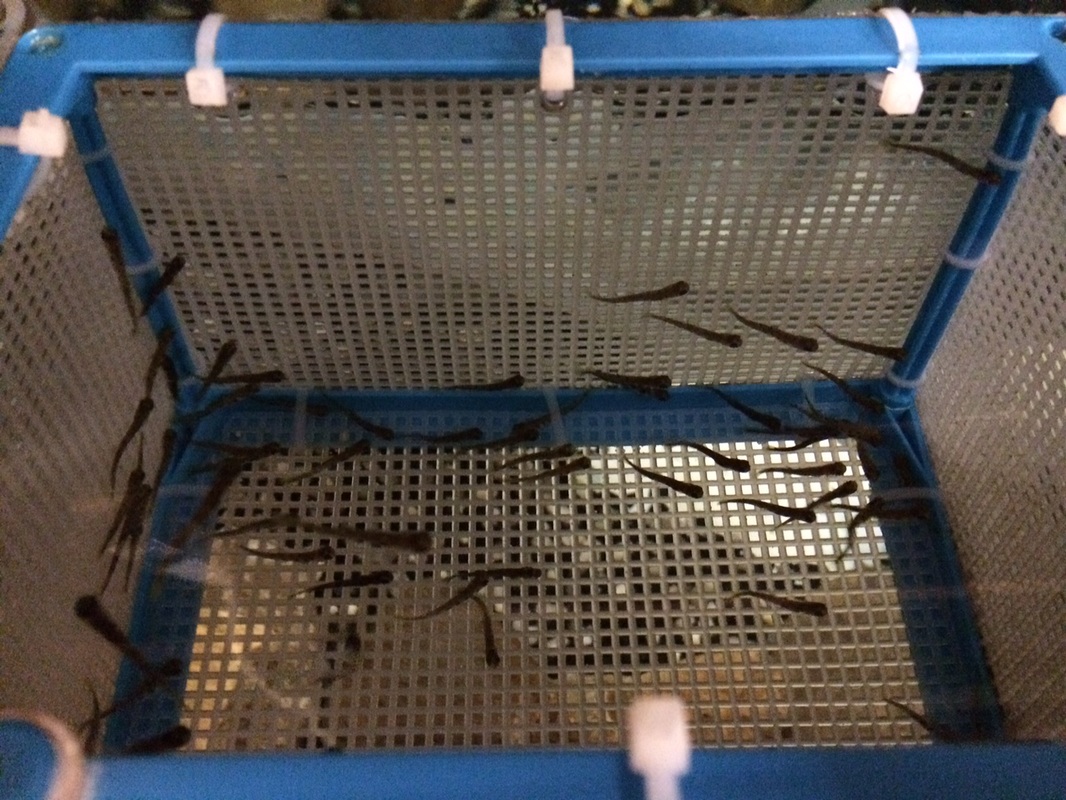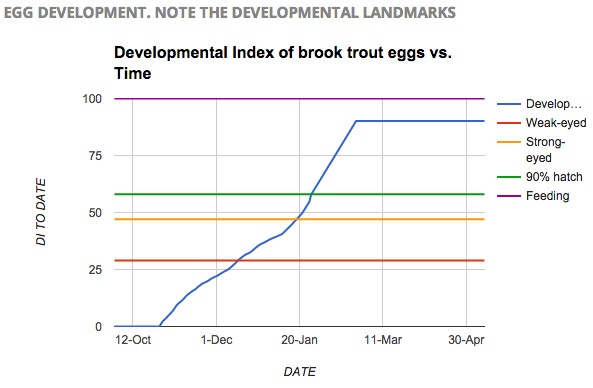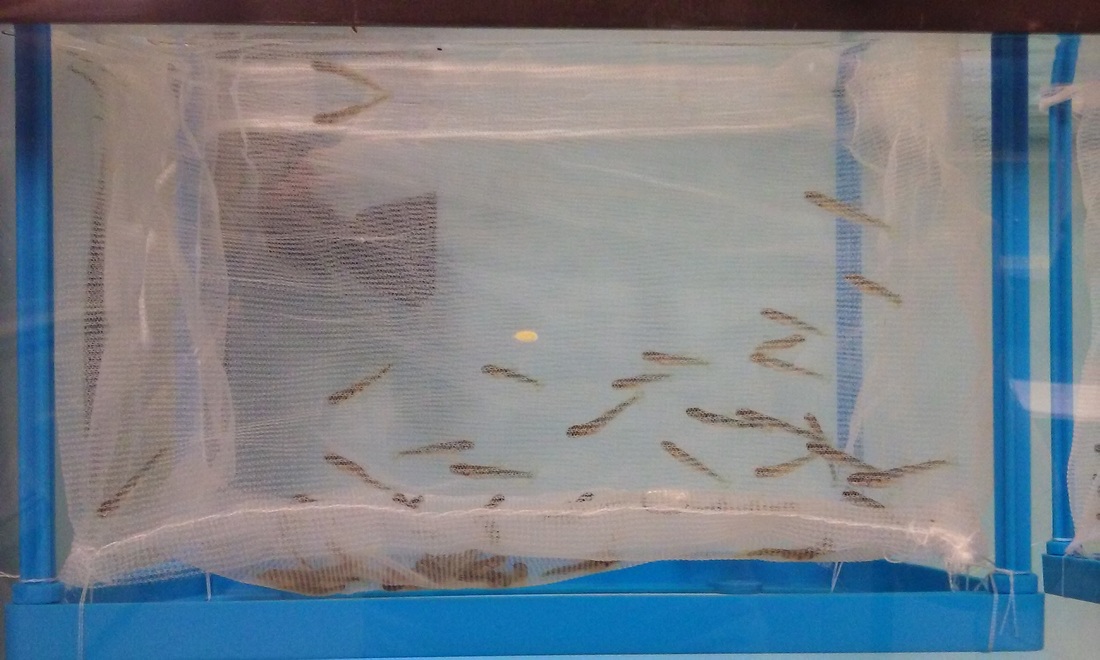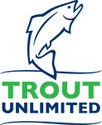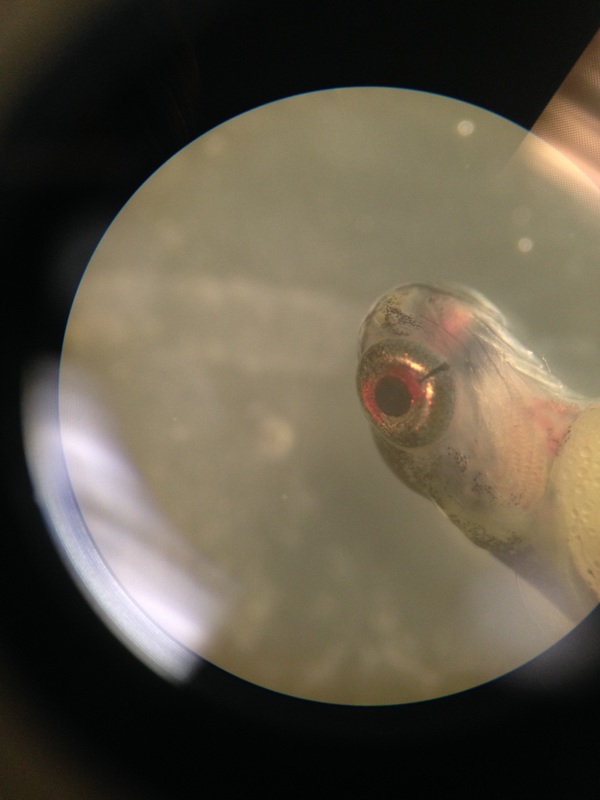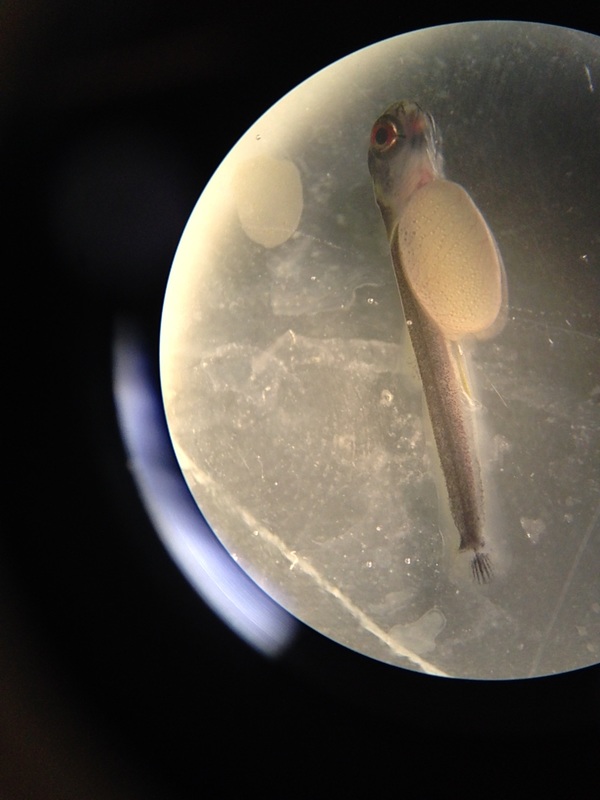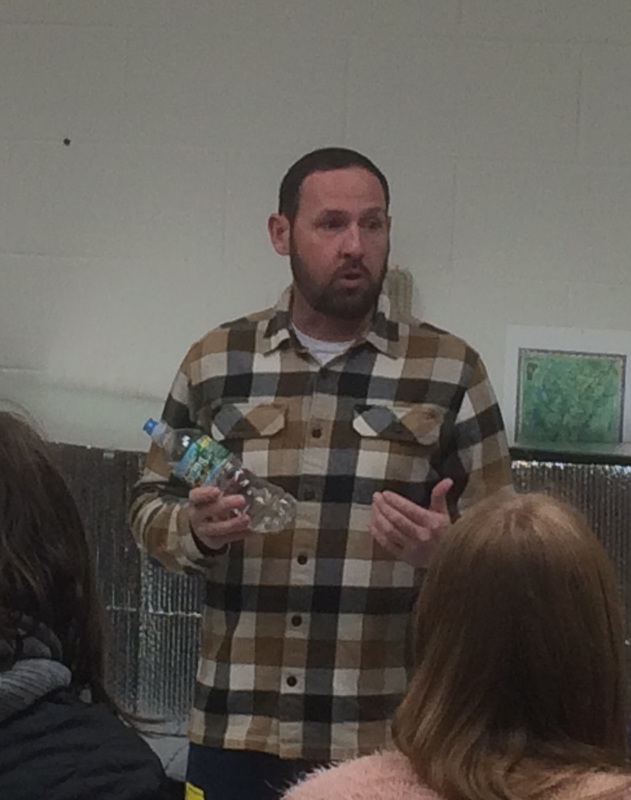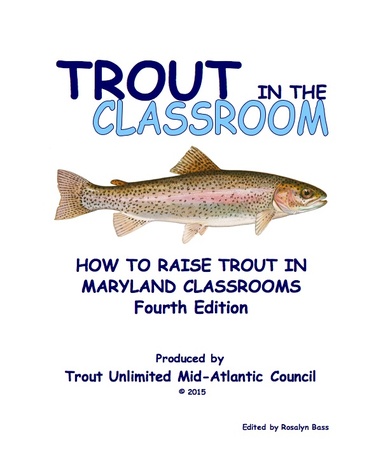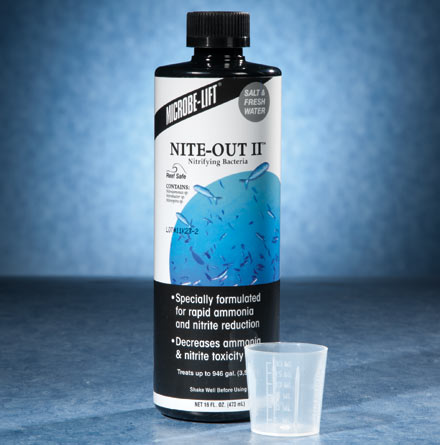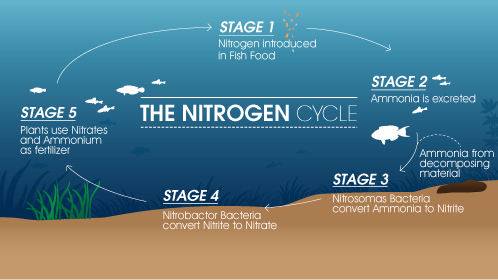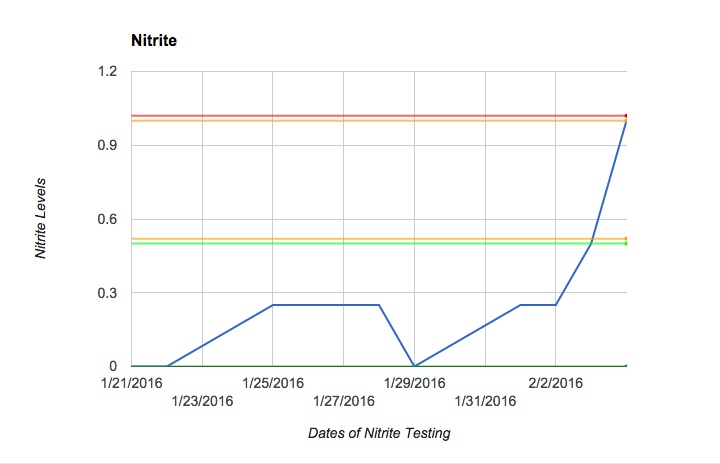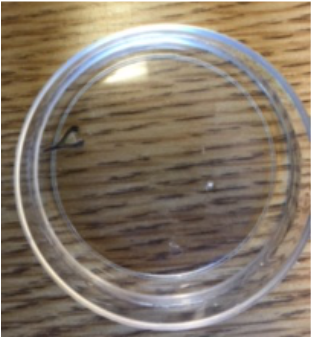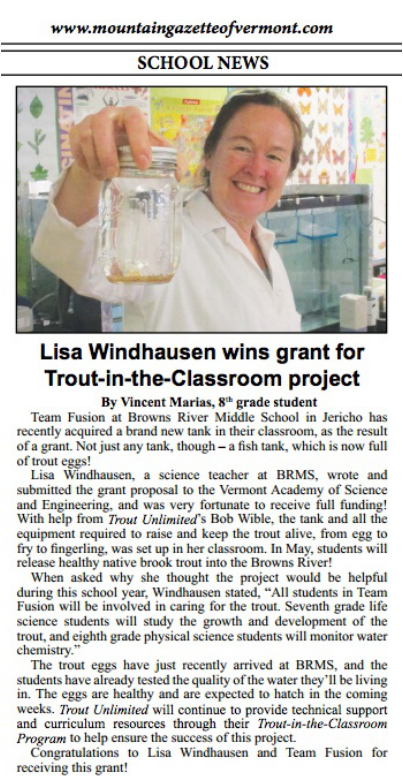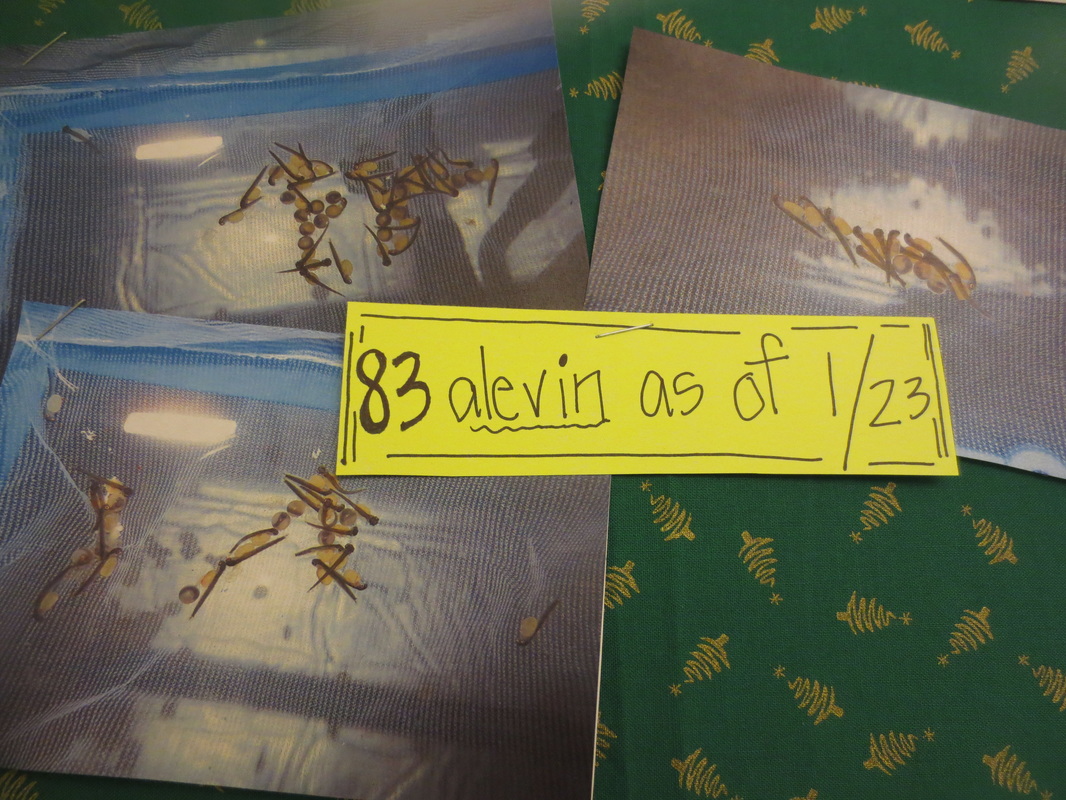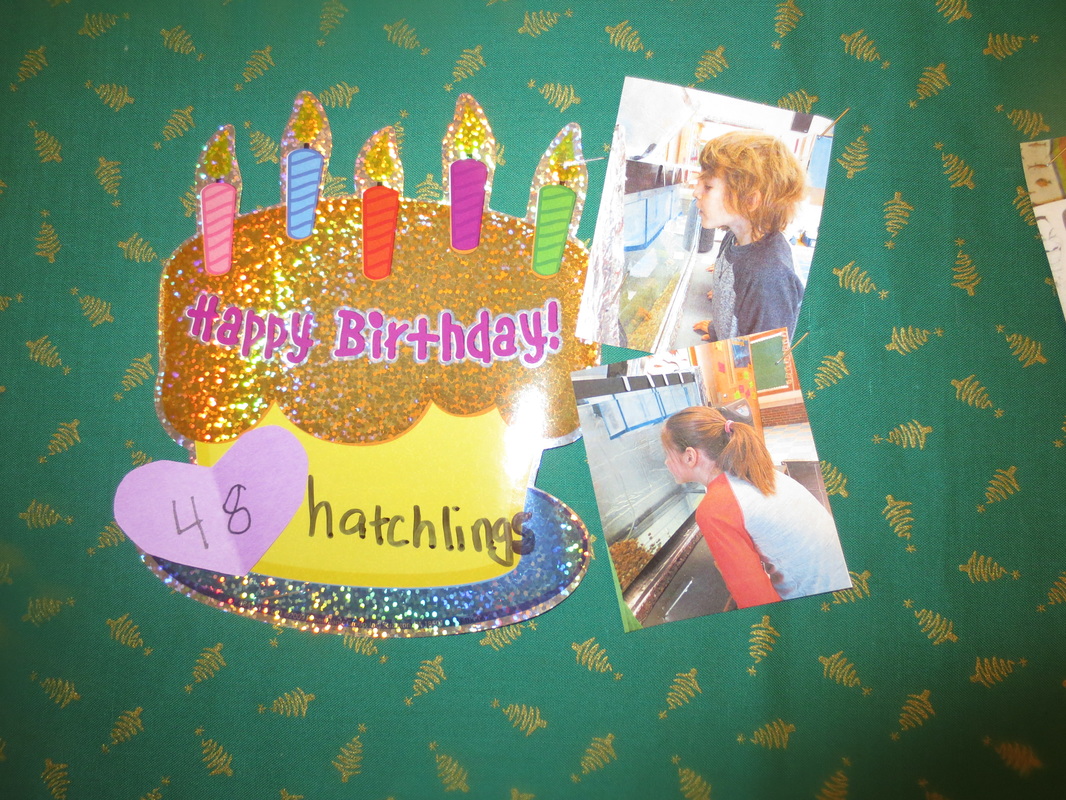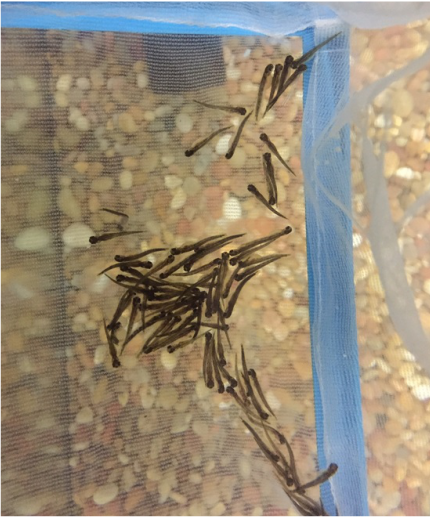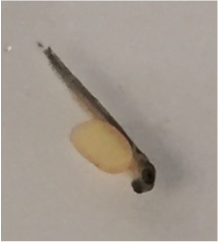TIC STREAMINGS
More Vermont Release Days: Ludlow, Hunt Middle School, and Mary Hogan, plus some great videos!
6/3/2016
On a cold and rainy May 24th when it sometimes poured, Ludlow’s third graders had a great, mostly outdoors, Release Day experience at Hawk Mountain Resort, where LES community volunteer and Trout Unlimited member Kathy Ehlers works.Here’s what the 72 LES fish looked like just minutes before being netted out of their classroom home.
The first activity of the day was macroinvertebrate collecting and classifying, which I led. Students found an abundance of macros, and we could tell from many pollution-intolerant species we found that the Black River in that location is a healthy stream.
Once we’d assessed the quality of the habitat where our new releasees would be living, it was time to let them go. After receiving a pint container with three to six fish in it, each student decided where to add their trout to the stream.
We all took a snack break; then several volunteers taught students fly casting, using equipment provided either by LES community partner Kathy Ehlers or by Hawk Mountain Resort. Those who weren’t learning the beautiful art of fly fishing played games. Now on to lunch!
Here’s a great video Scott Pease sent of their Release Day in Underhill.
I’m very impressed, Scott, not only by the video but also how quickly you were able to produce it!
Mary Hogan School.
Steve Flint held Mary Hogan‘s third Release Day on the upper Middlebury River near the Robert Frost trailhead. As always, Steve was incredibly organized and had recruited a veritable “cast of thousands” to help educate his students on topics that included marcoinvertebrates, stream dynamics and characteristics, the riparian zone, birdlife of the area, etc. Several individuals represented the Central Vermont Chapter of Trout Unlimited and/or New Haven River Anglers. Members of the Otter Creek Audubon Society staffed the birdlife station. A Middlebury College visiting professor of education also led one of the stations.
Since Paul Urband, of Central Vermont TU, and I hosted students at a site on the river where Irene relocated it, I was not able to take pictures of many students and volunteers. Here are just a few.
Middletown Springs released their fish on Tuesday, a day that started grey but became quite beautiful well before midday.
Teacher Jenn Tifft had recruited four volunteers: Hilary Solomon, Megan Muller, and Haley Macomber (all from the Poultney-Mettowee Natural Resources Conservation District), and me.
At 9:00, we walked from MSES to a stretch of the upper Poultney River quite near the school. Jenn divided the class in half for our first activities. Hilary and Megan supervised students as they tested a small tributary that flows into the Poultney near our release site. Haley and I took the other group to a spot on the river to talk about the characteristics of the stream: the canopy and the riparian zone more generally, substrate embeddedness, woody debris and other in-stream structure, undercut banks, evidence of flooding and erosion, etc. Then, using a tennis ball, tape measure, and stopwatch, the students measured the speed of the river.
After 45 minutes, we took a snack break at the end of which Hilary and I switched groups and repeated our exercises, only this time, Hilary had the students test the water of the main stem. While most results suggested that the chemistry of the tributary and the main stem were very similar, the phosphate level of the tributary was significantly higher than that of the main stem. Hilary led a discussion focussed on the question, “Why might that be?”
Our last activity before lunch was to play the energetic but also very educational “Macro Mayhem” game, which Hilary led. (Click the Macro Mayhem link above to get instructions on how to organize the game.) Here is a brief video of the MSES Macro Mayhem episode.
After a cafeteria/gym lunch of chicken and beef tacos, we returned to the stream to collect and classify macroinvertebrates. We found many of the good ones!
Here are photos from the MSES Release Day.
Wednesday, Manchester Elementary and Middle School‘s Release Day, was perfect from the start and took place at an altogether beautiful piece of property on the upper Mettawee River.I arrived at the school at 11:00 to help the students net and count their fish. Becki Trudell, program director at the American Museum of Fly Fishing, came to join the fun. Once the school bus delivered students and faculty to the stream, students, supervised by the many volunteers who had also come along, broke into small groups to collect and classify macroinvertebrates. Again, a successful activity! Along with the bugs, students also found small trout as well as eggs, both viable and dead. We assume the seemingly viable eggs must have been those of a rainbow trout.
After the macros activity, each group of students received a container of six or seven trout, which they took to the special spot they’d chosen to release their fish. When, up and down the river, the various assemblies of budding ichthyologists let out a whoop, we knew that another half dozen brookies were now in their new homes.
We ended circled up on the lawn for thank-you’s and final reflections. I took that opportunity to ask the students whether they had enjoyed these activities. All had. Then I asked whether someday they’d like to do this kind of work for a living and get paid for it. A great many said they’d love to do that. I urged them to study hard, go to college, and pursue that passion.
At 8:30, Keith Harrington, Poultney Elementary School fourth grade teacher, and his students began walking to the release site while two of Keith’s students and their mothers netted and counted the PES fish. There were 75 of them–a nice number–which they put in an aerated cooler. Then we transported the trout to the Poultney River at a point where it wraps around the west side of the Green Mountain College campus.
After scoping out the river with Beth Miller, education and outreach specialist with Poultney-Mettowee Natural Resources Conservation District (P-MNRCD), we picked the area where the students would release their trout, and Beth helped me carry the cooler to that spot. We placed it in the shade.
Keith assigned his students to four groups of five or six students each that then rotated through stations spread up and down the river to participate in 45 minute learning activities.
At one station, Green Mountain College biology Professor Natalie Coe taught students how to test river water, including for chemical compounds they didn’t test for in their classroom. Beth Miller introduced students to the physical characteristics of the stream and its surrounding riparian habitat. Megan Muller, recent GMC graduate and intern with P-MNRCD, used a “stream table” to demonstrate to students how rainwater moves through a watershed and how pollution–cocoa powder in Megan’s simulation–would be distributed if it were introduced into the system. Haley Macomber, UVM senior and summer intern with P-MNRCD, helped me explain the procceses of collecting and classifying macroinvertebrates.
PES’s release occurred in the middle of the day, following remarks by Keith Harrington, who also thanked the Poultney Rotary club and a generous anonymous member, who funded the start-up of the PES TIC program. Keith also presented the beautiful TIC quilt that a PES parent and grandparent assembled out of squares made by PES students and, especially, students at 25 other schools across the country. Finally, each student read a trout reflection essay that he/she had written. All together, it made for a great send-off for their 75 trout.
Here’s a video of one of the PES students reading his trout reflection essay.
Pulling into the LCS parking lot, I was impressed by the number of cars saddled with three or more inches of heavy, wet snow, but as I snaked the last few miles up Lincoln Road, the “hoar frost” on the over-hanging mountains signaled the weather we should expect for Lincoln Community School‘s Release Day. Indeed, when I checked my fishing thermometer, the air temperature was 40 degrees, identical to the temperature of the beautiful New Haven River, curving around the back side of the school. Just two days earlier, the river had been 50; so our young fry, who’d been living in a comparatively comfortable 50-degree classroom tank, were in for a thermal shock.Intermittent snow flurries punctuated a day that was glorious in spite of the weather. Here’s some of what the day looked like.
LCS had terrific community support for its Release Day. Several members of the Central Vermont Chapter of Trout Unlimited contributed, including chapter TIC liaison Bob Wible and his wife Nancy and Nancy Crandall and Doug Zehner, who taught fly casting both outdoors and in the school gym.
Joe Nelson introduced students to riparian forestry; and Craig Zondag, of the Otter Creek Audubon Society, led students through the riverine woods in pursuit of songbirds. Steve Atocha, owner of Middlebury Mountaineer, taught the 5th and 6th graders beginning fly tying; and Ashley Eaton and Sam Clerkin from the Lake Champlain Sea Grant program–Watershed Alliance, paying a second visit to LCS, guided a macroinvertebrate collecting and classifying activity. Also assisting were members of the New Haven River Anglers club.
Four groups of students, eight to nine in each group, rotated among the four activity stations that had been set up. When each of the groups finished their macroinvertebrate collecting activity, we took the students back to the classroom and asked, “How long is it going to take the trout to adjust to finding natural food in the stream?” As with the MEMS students (see previous blog post), the guesses were all over the place, but most students didn’t think the adjustment would be–INSTANTANEOUS! As it was.
I can’t think of a better way to teach the concept of instinct.
Finally, shortly before 2:30, Bob Wible, teacher Mikaela Frank, and I transported two coolers–holding, how many? 143 very healthy-looking brook trout!–down to the banks of the river and got organized for the release. Within minutes, all the other students and teachers at LCS joined us to celebrate an unusually successful Trout in the Classroom season. After brief remarks, the fish were released into their new–now we know–macro-filled home, and everybody cheered.
PS: To date, with the exception of two schools that kept their tanks very cold (38 or 40 degrees), the LCS total is a state record. Of course, at least two dozen schools are still growing their trout, so that could be eclipsed.
But, both quantitatively and qualitatively, LCS had a SUPER year! Thanks to Mollie Sprague (now on maternity leave) and Mikaela Frank for all their hard work and diligent attention. (I hope to follow this with a blog post that describes some of the many enrichment activities that Mollie and Mikaela introduced to their school’s TIC program.) Thanks too to Bob Wible, who provided unwavering support.
When we’d finally netted the LCS trout out of their tank and were able to count them, Mikaela, who thought they might have had “80 to 100,” had this to say.
Earlier today, Ludlow Elementary School‘s Lisa Marks and her 3rd grade students got some very good news.Lisa had entered the wonderful book of TIC-related water color paintings and text that her students had created into Scholastic Magazine’s national “Kids Are Authors” competition. This is the 30th year of this prestigious award, which annually receives 1,500 to 2,000 entries. Scholastic awards a first place winner and 25 honorable mentions. Never before has a Vermont school made the list, but in the final year of the competition, LES was chosen as one of the honorable mentions.
I addition to this very special honor, Ludlow Elementary will be able to purchase $500 worth of books of their choice.
Congratulations Lisa and students!
For those of you who haven’t seen or don’t remember the Ludlow Elementary School’s student’s beautiful artwork and text, you can find it on the slide show page here.
A new type of fish food!
5/14/2016
On Friday, May 13, I taught two classes of Manchester Elementary and Middle School 6th graders about macroinvertebrates. Teachers Seth Bonnett andMelissa Rice turned their students over to me for two wet and wonderful hours, one hour per class.
Earlier I’d gone to the Mettawee River, where next Wednesday MEMS students will release their trout, to collect macros. I brought two coolers that I’d adapted with battery-powered aerators and digital thermometers. I also brought a home-made “kick net” (two 3-foot-long sticks with netting/screening stapled to them) and several frozen bottles of water to keep the temperature cooly stable. A rudely timed downpour drenched me as I was right in the middle of my collecting activities.
I used a PowerPoint presentation to explain macros and, especially, introduce students to the three principal species of living trout food that we hoped to find in the Mettawee: mayflies, caddis flies, and stone flies. One of the PPT slides took us to a four-minute YouTube video (below) that explained how, by collecting macros, one can calculate the Biotic Index of a stream, a measure of its health.
Teacher Bonnett assigned students to one of five groups, each of which got a kit of supplies, including collecting tools, containers, and macro identification charts.
Then I put approximately two quarts of debris- and macro-filled stream water into every group’s wash basin and told them to find, classify, and count the macroinvertebrates. Finally, the students used their insect data to calculate the Biotic Index. (Well, actually, not all of the groups got to that point in the time we had available, but some did.) It seemed that the students, even the initially squeamish ones, really enjoyed the activity.
As we were wrapping up, I asked the students how long they thought it would take for the fish to learn to feed on the natural insects in their new environment as opposed to the artificial food they’d been eating for the last few months. Guesses ranged from a month or more to “instantly.” So I suggested that we should see what would happen if we put the macros they had in their collecting dishes into the room’s trout tank. When the first group poured their bugs into the water, their shrieks and cheers gave away the answer. “Instantly” is right!
I can’t think of a more powerful lesson in instinct.
Here’s a short video of that moment when a MEMS girl pours her groups macros into the tank.
Time to release the fish!
5/10/2016
Vermont schools have begun to hold their Release Days.
The first in my area of southwest Vermont occurred last Friday when 24 Dorset School 5th graders released, conveniently, 24 beautiful brookies. Here’s a slide show of photos from that day.
Here’s a partial schedule of 2016 Release Days.
- May 6, Dorset School
- May 12, NewBrook Elementary School
- May 13, Rutland High School
- May 13, Williston Central School
- May 16, Lincoln Community School
- May 17, Middletown Springs Elementary School
- May 18, Fair Haven Grade School
- May 18, Manchester Elementary and Middle School
- May 20, Poultney Elementary School
- May 24, Green Mountain Valley School
- May 24, Ludlow Elementary School
- May 25, Hunt Middle School
- May 25, Mary Hogan School
- May 25, Pownal Elementary School
- May 27, Cambridge Elementary School
- May 27, Harwood Union High School
- June 1, River Rock School
- June 3, Benson Village School
- June 3, Poultney High School
- June 6, Bethel Elementary School
- June 8, Shaftsbury Elementary School
Mollie Sprague and Mikaela Frank at Lincoln Community School–with the help of TIC liaison Bob Wible and Doug Zehner and Paul Urband, two members of the Central Vermont Chapter of Trout Unlimited–provided a wonderful dissection demonstration and hands-on learning experience for LCS 5th and 6th graders.Here is the great slide show Mollie put together.
The national office of Trout Unlimited works hard to recruit youth who will be the next generation of stewards of our environment, especially its cold water rivers and streams. Toward that end, it has created the Stream Explorers program, designed to appeal to elementary and middle school students.
The Stream Explorers program also provides informational and educational materials for parents and teachers to use with their children. These attractive, colorful four-page documents include interesting stories on topics such as trout food, trout life cycle, watersheds, human impacts on trout habitat, etc.
Click the following link to go to the folder containing eight Stream Explorer publications.
Joe’s TIC “dance card” is filling up fast with Release Days. My first of the season will be this Friday, when the students of Karli Love’s 5th grade class at the Dorset School will release their fry into the upper Mettawee River in Dorset Hollow. They’ll also be collecting and classifying macroinvertebrates and learning how to “read” a stream and its diverse sections/areas.I’ll have most of next week off, but after that, I’m signed up to help with six Release Days in 10 days, on May 16, 17, 18, 20, 24, and 25. It’ll be a busy week and a half!As an example, here’s the schedule I got from Mikaela Frank for Lincoln Community School’s Release Day on May 16.
I just got back from the Castleton River near my home on a grey and rainy Wednesday afternoon when the air temperature was 48 degrees.So what was the river’s temperature? 46 degrees!That’s not an indication of what the temperature of your release stream is at present, so you should get out there and measure it. But almost certainly, waters will start to warm rapidly over the next two weeks, as the daytime temperature will be well into the 60s for most of that time.Finally, on a hike with my Hornbeck canoe into Little Rock Pond in the Green Mountain National Forest on Monday, I encountered many beautiful wild flowers. Here are two photos I took.
Erik Anderson, of Chelsea School sent this message on April 26:Here is a picture taken by Chelsea 6th grader Maddy Rooney. In each photo you can see the lump on the underside of the trout. The coloration of the lump was very similar to that of the eggs as they were in later stages of development. This lead the students to hypothesize that the lump was an undeveloped twin.We are not sure how long the fish was dead in the tank. Possibly 3 or 4 days. We discovered it while using the siphon to clean the gravel. The little particles surrounding the fish were stuck to the fish when we retrieved it from the siphon. My guess is that these are either yeast or bacteria colonies.
Further update on Chelsea trout: They all survived April vacation and are significantly larger than when we left. Today we gave them their first taste of macro-invertebrates and they responded vigorously. Below is one of the pictures Maddy took.
Thanks for the great photo, Maddy!
In response, I sent Erik‘s report and photo to Green Mountain College Professor Meriel Brooks, who kindly replied with the following.
It’s really hard to tell what that might be. I think of things like tumors and parasites when I see lumps on fish. Usually fungi are lighter in color, and the color itself looks like the little fish’s melanophores (pigment cells). You might be able to determine with a microscope (dissecting scope). It’s likely to be a tumor of some sort. The tan stuff is also hard to determine–resolution is not good enough–both bacteria and yeast would be likely suspects. I assume those grew after the fish died.
Stream-study presentations
Guy Merolle‘s students at the Castleton Village School gave a wonderful series of presentations based on their research into diverse characteristics of the Castleton River, which flows east-to-west just north of their school campus.
They addressed the following topics:
- What is a watershed? What is our watershed?
- What factors affect the health of a watershed?
- The characteristics of good brook trout habitat;
- Macroinvertebrates;
- The importance of forest canopy;
- The temperature and chemistry of a river;
- The characteristics of the river bottom;
- Its width, depth, speed, and volume;
- Erosion and deposition;
- Dissolved oxygen;
- The significance of surrounding impervious surfaces; and
- Invasive species.
Castleton University Professor Andy Vermilyea attended the students’ presentations and, subsequently, shared some of the research that he and his students have been doing on the Castleton River.
Here are a few slides from the CVS student presentations.
On 4/27, Ludlow Elementary School‘s Lisa Marks and her students tacked on a visit to the Orvis “flagship store” in Manchester to a school field trip to Hildene. Here’s Lisa’s report:Yesterday we were down at Hildene Farms, taking part in a one-room-school-house program and on a whim decided to call Orvis to see if we could stop in. They were more than happy to have us stop by. They gave us a bucket of food to feed the trout, talked with us about the fish, let the kids look at flies, and offered their restrooms which meant having kids walk around the store a bit. They were extremely welcoming, and the kids had such a good time. The best part is that we didn’t lose anyone in the trout pond!The fish in our tank are doing great!Here are some pictures Lisa sent me.
It’s not uncommon for a TIC school to lose all or almost all its fish. Last year, Guy Merolle, of the Castleton Village School, returned from the 8th grade trip to Washington to discover that the chiller had been turned off. The water temperature was 75 degrees. When he had left for D.C., Guy and his students had more than 75 fish; now all but four were dead.When Jenn Tifft‘s students at Middletown Springs Elementary School learned of this tragedy, they voted to donate some of their trout to CVS. Here’s a picture of Jenn and her MSES students as they were about to put their fish in my car. Below that picture is one of CVS students happy to be getting a few more trout from MSES.
Well, this year it happened again.
When Jessica West‘s 3rd graders at Shelburne Community School learned that the students of Eden Central School lost all their fish, the SCS students, too, decided to make a donation.
Bob Wible, TIC liaison for the Central Vermont Chapter of Trout Unlimited, visited Shelburne on April 6 to accept 30 beautiful fry raised by SCS students. Shelburne students asked Bob many questions about the water conditions of the receiving school, for example, was the temp 52 and was the water clear and clean.
Above, Shelburne Community School trout philanthropists.
Then Bob drove 62 miles to the Eden Central School to deliver a very special present to Kara Rublee’s and Betzi Goodman’s 5th and 6th graders. Bob told the Eden students about the Shelburne students’ concerns. Immediately the students started doing water tests. They were also surprised at how large the parr were and wanted to know how much large they might get.
Here’s a photo of Bob with the Eden students just before resupplying their tank.
Look at those lovely fish!
Thank you, Shelburne students!!
But…
Transferring trout between classroom tanks can’t be done without authorization. Before arranging to add some of the SCS trout to the Eden tank, Bob asked for and was granted permission to do so by Tom Jones of the Vermont Department of Fish and Wildlife.
What else is going on?
Finally, it looks like some of the tanks that have had persistently high ammonia for a long time are starting to cycle. After two weeks of ammonia readings of 4 ppm at Ludlow Elementary School, late last week ammonia finally dropped to 2 ppm. Just as important, nitrite has slowly started to rise. This may have something to do with the fact that last Sunday, teacher Lisa Marks and her community partner, Kathy Ehlers, added two more bags of Chemi-Pure to their filter. LES was one of several schools using the Fluval 406 filter that received two rather than the recommended four containers of Chemi-Pure.
As I wrote Lisa in an e-mail, “Hallelujah!
And Lincoln Community School may finally be turning a corner too.
On April 8, I got this report from Bob Wible:
I just left the Lincoln tank, and ammonia is still at 4 ppm. The good news is that the nitrite reading is definitely not 0. It is between 0.0 and 0.25, which is progress. Fish look very healthy and are eating well, and there’s been some cannibalism. Checked the filter and added a 3rd bag of Chemi-Pure. Hoping nitrites continue to improve over the weekend.
About cannibalism, which is natural, I wrote the following.
Sometimes it’s desirable to place overly aggressive trout in the “time-out” room, that is, a net breeder put back into the tank for that purpose. Alternatively, some teachers have had good results by scooping up the smallest fish and returning them to a breeder basket for a while, where they can feed with less competition.
Of course, Charles Darwin would never approve.
One last thought.
Both Ludlow and Lincoln have high pH. They didn’t realize this until they performed the high-range pH test. Ludlow’s is 8.4; Lincoln’s is 8.2. I’m beginning to wonder whether this may have something to do with the delayed start of the nitrogen cycle. Does anybody have any thoughts about this?
At 7:00 a.m. in Castleton on April 5th, it was 9 degrees Fahrenheit! OMG! And I’m writing about Release Day? You gotta be kidding!
Here’s what the Castleton River near my home looked like Monday afternoon.
The air temperature was 23, the water 32. Brrr! Those white dots are snowflakes. (We’ll get back to matters of temperature towards the end of this blog.) But for now . . .
The what of Release Day
Release days can be big or small, simple or complicated. Most release days span about two-and-a-half to three hours, but some take less than half an hour. Last year Castleton Village School’s Guy Merolle connected his RD to an annual all-school event that involves students and teachers traveling to a local state park to learn about and pull invasive plants. On the way to the park, the school bus stopped at the release stream; everyone de-boarded; Guy spoke about the history of the CVS project and what they had learned; designated students released the seven remaining trout; people took pictures; everybody cheered; and students got back on the bus and headed for their service-learning project.
Here’s a picture of Guy and his students.
This Web site has several YouTube videos of RDs at different schools, some in Vermont, some elsewhere. (The last one is a bit quirky, but it may give you ideas,) If you search on YouTube, you’ll find even more. Our Maryland TIC manual has a separate section on RDs with lots of great information/suggestions. In the latest manual edition, it’s Chapter 9.
Here’s a link to the RD videos on this site.
Simple, brief releases are self-evident, and I’m sure you don’t need my suggestions for those. Just be sure you’ve followed the guidelines in my last blog for the where of RDs, especially those related to safety.
If you have the time and want to plan a longer and more multi-faceted RD and if you can get the volunteer help, here are a few ideas.
- Teach students how to analyze the release stream, finding its runs, pools, pockets, and riffles as well as its woody debris, underwater structure/protection, and the trees and shrubs that provide protection from predators and excessive sunlight.
- Study and evaluate the quality of the “riparian zone” (if you don’t know what that is, look it up; it’s very important).
- Collect and classify macrovertebrates. (Look for the macros charts within the Insect identification charts folder in the TIC Resources collection. Print these in color on card stock and laminate them.)
- Use the “macros” data your students generated to calculate the stream’s “biotic index,” a measure of its health. (Check the same folder mentioned above to find one or two biotic index worksheets.)
- Estimate the volume of the stream.
- Measure the speed of the stream.
- Test stream water, including for phosphates.
- After doing 5 through 7 above, you could, if you wanted, have students of a certain academic age calculate the “phosphate load” being delivered from that point on the stream to the watershed below.
- And perhaps the piece de resistance: “electro-fishing.” This, usually conducted by a Fish and Wildlife staff person, involves putting an electrified probe into the water to temporarily stun fish so that you can examine and measure them, etc. It’s always a hugely popular demonstration.
In addition, if you’re very fortunate in terms of the resources/opportunities of the release site and if you’ve found the right volunteers, here are some further possibilities.
Kathy Ehlers, TU volunteer at Ludlow Elementary School, works at Hawk Mountain Resort, which LES will use as a release site. Thus, their students will be able to:
- feed the 12″ rainbows in the resort pond,
- have a rudimentary fly casting lesson at the pond (Orvis will lend 15 fly rod and reel outfits),
- hike the resort trails to a beaver pond, wetland, and other diverse habitats, and
- have a picnic on the resort grounds.
Clearly, this kind of opportunity won’t be available to the vast majority of schools, but this list may give you an idea of what could be possible under the right circumstances.
Finally, you’ll want to release your fish. Releasing your fish as the last activity of the day allows tension and excitement to build.
If you have only a very few fish, you could have one student, on behalf of the whole class, release them all. That student could be chosen by lottery, elected by the class, or the student who, on a basis of a point system you designed, won the honor.
Many classes have enough trout to allow each student to release at least one fish. Sometimes, the RD plan is group-based, and, in that case, each group may be allocated a percentage of the total number and allowed to decide how their group wants to do the release.
However you choose to approach it, it’s desirable to get everyone together at the end and ask for reflections/reports, and perhaps to celebrate with a cake or cupcakes.
The who of Release Day
Depending on how ambitious your plan is and depending on whether you need volunteers with special knowledge or skills, you’re going to want somewhere between a few and many volunteers to help you. (That’s one of the reasons I’m writing about this almost two months ahead of time.)Here are some categories for potential volunteers/helpers:
- fellow school staff members
- parents and grandparents
- Fish and Wildlife staff (especially for electro-fishing demonstrations)
- Trout Unlimited members
- Audubon Society members
- if you have one, the local “watershed group,” e.g., White River Partnership, Friends of the Winooski River, etc. (Review the list found here to see if there is a group in your area.)
- the local “natural resources conservation district”
- other sportsmen’s groups, e.g., New Haven River Anglers, etc.
Fish are adaptable to a degree, but unlike humans who apparently can survive the mid-winter Polar Plunge Challenge as well as a dash from a snowbank into a roasting sauna, if at all possible, trout shouldn’t be subjected to thermal shock.You’ll recall that in late-December and early-January I frequently updated you on the temperature of the water at the Roxbury Fish Culture Station so that you could adjust your tank’s temperature to be as similar as possible to the hatchery’s. Now, as your Release Day approaches, you need to take responsibility for determining the temperature of either your release stream or at least a proxy for it, that is, another area stream the temperature of which is likely to be close to that of your designated release site.You can either do this yourself or recruit a volunteer, parent, or partner to do it for you. I’d suggest that you check the temperature a week before your release and then again two or three days before.I keep a thermometer on a 20-foot string in my car so that, if I cross a bridge over a trout stream and have an extra three minutes, I throw my thermometer into it, keep it in the water for a minute, and check the temperature.Publicity
Release Days are exciting events for students, teachers, parents, and community partners, but members of the press love them too! I’ve found that reporters and, if they have them, their colleague photographers are often eager to leave their offices in spring to join a group of enthusiastic kids as they slosh around in a stream, finding magical things.The more positive publicity we can get for TIC, the more other schools and their parents will want to adopt the program. It may also open the door to new funding sources. If the press covers your release event, please be sure to thank those who provided financial and human support, including, if you’d be so kind, my organization, Trout Unlimited.As my former secretary used to say (and probably still does), “Have a nice day!”
I saw these wonderful pieces while visiting Ludlow’s students last Friday. Lisa had invited me because her students had more than 28 questions they wanted to ask me! For almost an hour, I did my best to field the students’ often very thoughtful questions. Then we teleconferenced with “The Big Guy.” Chuck Dinkel, Maryland TIC coordinator, who had agreed to allow me to call him–in California while he was visiting his 99-year-old mother!–so that the LES students could ask him the questions I couldn’t answer. For the next 35 minutes, Chuck was wonderfully informative, encouraging, and humorous.
Here’s a photo of the LES students, community volunteer Kathy Ehlers (in stripes), and me (in the orange TU hat).
But on that visit, there was also some important work to do. Lisa’s tank had for over a week been running ammonia levels of 4 ppm. None of us have been able to understand why that’s gone on for so long and, especially, why her nitrite readings were still at zero. One of the concerns was that this may be due to the large amount of light-brown debris that was accumulating on intake surfaces and especially apparent when anyone siphoned the gravel. At first we thought it was algae.
To the upper right you can see what it looks like. Gross, huh?
Chuck looked at this picture and sent it to a biologist at the Maryland hatchery. He suggested that I do the same; so I sent it to Jeremy Whalen in Roxbury. Jeremy said:
The light brown stuff is bacteria/fungus growing from the uneaten feed, most likely it’s getting caught in that filter and using it as growing media. Given the higher protein levels in starter feed, it’s fairly common; just do the best you can to remove it. It wouldn’t even hurt to pull the filter off and wash it in the sink (short shut-downs for that if necessary won’t hurt). Just do it first thing in the morning before first feeding. That could also be contributing to the higher ammonia levels as well. If the fish are eating well and growing, there is less concern with the ammonia levels. The time to start worrying is when they stop feeding. I think she’s on the right track by reducing feed levels.
The Maryland fisheries biologist said something similar, so we relaxed because it seemed that we had the scientists at our back.
On the left you can see the recent test indicating ammonia of 4 ppm, but on the right is a photo, taken 4/3/16, of Lisa’s healthy-looking fish. The video below confirms that as well.
Lisa’s pH had been registering 7.6, the top of the regular pH test scale, so I suggested that she do the high-range pH test. She did that, and it turned out to be 8.4!
Post script
There are two thorny questions imbedded in the details of what’s going on at Ludlow:
Why are their fish not dead?
This is a baffling question. We know ammonia is supposed to be bad for trout. And the latest science we’ve received (see “Article about relationship among ammonia, pH, and temperature” in the Water Chemistry & Trout Health collection), tells us that Lisa’s tank conditions should be near-lethal for the fish.
At the Ludlow tank temperature (52 degrees F or 11.1 degrees C) and with their pH of 8.4, a minuscule TAN (total ammonia nitrogen) reading of 0.4 should be toxic for trout; yet they appear healthy! (Remember TAN, which our test kits measure, is a combination of the toxic ammonia and the benign ammonium.)
I can’t explain why Lisa’s fish are doing so well under these circumstances. Perhaps it’s because Lisa and her students love them so much. (Just kidding! But they do.)
Why is nitrite not rising?
The answer may have to do with their filter configuration. Guidelines for filter set-up have changed. We used to use two containers of Chemi-Pure, now we recommend four. But the equipment list in circulation in the fall still called for only two containers, so Lisa and Kathy improvised. They used a zip-tie to divide each bag in two and hung it, like a saddlebag, over the plastic divider between the two of the compartments of each basket. (I did something similar at several schools I assisted except that rather than keeping the two half-bags connected, I used twozip-ties, cut the bags apart, and set them down of the floor of the compartment.) It may be that, suspended over the plastic dividers as they have been, Lisa’s Chemi-Pure has not had enough water flow to allow nitrifying bacteria to develop adequately.
Over the weekend, Lisa bought more Chemi-Pure, and on yesterday, she and Kathy added it to their filter. Let’s see if that helps!
If this works and nitrite starts to rise (it will probably take a while for the bacteria to get established in the Chemi-Pure), you’ll hear a deafening, happy cheer from one Ludlow Elementary School classroom!
This is exciting work, isn’t it?
Release Day #1: when and where?
3/30/2016
This Friday, it will be April. Eight days after that, Vermont’s trout season opens. And the weather’s getting nicer every week. So it’s time to start planning your Release Days.
When?
Most schools schedule their Release Days for the last two weeks of May or the first week of June. A few go earlier, but those three weeks tend to be a time when you can count on the weather: it won’t always be sunny, but it probably won’t be too cold.
Depending on what you plan to do at your Release Day–more on this in my next post–you might also want to schedule a back-up rain date. It’s not that you and your students can’t have a very successful Release Day in the rain, but a downpour could “dampen” most people’s spirits, and raging torrents because of days of heavy rain would pose serious risks.
Most schools transport students to Release Day using school busses. If that’s going to be the case for you, you may need to get your reservation in ASAP and perhaps even schedule your release around the availability of transportation.
A final consideration is the availability of volunteers. Most schools plan Release Days that include a variety of in-stream or stream-side fieldwork activities. In almost every case, it’s helpful if not necessary to enlist the help of parents, co-workers, Trout Unlimited members, or other community volunteers. You wouldn’t want to schedule your Release Day at a time when the volunteers you need can’t attend.
Where?
Remember that Tom Jones of the Vermont Fish and Wildlife Department needs to approve your release site. Normally that is done in the fall as part of the process of requesting eggs. If for some reason you did not request his approval, you can contact him at tom.jones@vermont.gov.
Depending on where your school is located, you may have several fabulous release site options close by or you may have no good options without traveling a distance.
What’s the perfect release site? I often describe it as “skinny water,” a small tributary brook that’s just big enough to support trout and the bugs that will sustain them but small enough so that nobody, not even your most over-eager young student, can get into trouble.
Here is my wish list of the ideal characteristics of a great release stream:
- a “safe” stream, ideally three-to-six feet wide with water not much deeper than eight or ten inches,
- close to a location where you can safely de-board students from school busses, preferably without having to cross a road,
- with adequate parking for the school bus(ses) and cars of volunteers,
- with easy access to the stream, that is, no steep banks,
- ideally with an “assembly space”–such as a cleared stream bank, meadow, or lawn–where you can meet before and after activities for such purposes as giving instructions, breaking into groups, reporting on what you’ve found or learned, etc.
- on public land or on private land that you’ve been given permission to use.
Below I’ve inserted a few pictures of streams that I consider terrific release sites. I took all these photos this past Saturday, March 26th. Your local streams may look different.
Finally, if you’re having trouble finding a good release location, ask for help, either from (a) stream-fishing-inclined parents or community members you know, (b) your area Trout Unlimited TIC liaison, or (c) me.
Good luck!
The next blog post will address the who and the what of Release Days. Stay tuned!
The Big Guy weighs in!
3/28/2016
Make sure teachers add 1 teaspoon per 55 gallon tank for a 17.9 ppm increase and not 1 tablespoon. I’ve had a couple of teachers who misread the Tsp and Tbs notations and added too much. Also, the carbon from the baking soda is the food source for the autotrophic bacteria. NiteOut II bacteria are autotrophic and use KH as a source of carbon during the nitrification (oxidation of ammonia to nitrite and then nitrates) process. When KH drops, the pH also tends to drop, and around a pH value of 6.0, the bacteria stop reproducing.About high ammonia, he offered this:
We know that as pH increases towards 7.8, the ammonia component of the ammonia test increases while the ammonium component decreases. I used to think that having an ammonia test reading of 3 or 4 at a pH of around 7.2-7.4 was okay, since most of the reading was ammonium. The fish could tolerate this. However, I have since determined, from a review of the chemical equations taking place, that both the ammonia and ammonium participate in the nitrification process and both have to be converted to nitrites and nitrates by the NiteOut II bacteria. So the bottom line is it is really a good idea to keep the ammonia reading low so as to reduce the work required by the bacteria to oxidize the ammonia plus ammonium. He also commented on the subject of cloudy water:
Cloudy water is often caused by excess nutrients in the water. Make sure teachers are proactive about siphoning the tank bottom and gravel to remove excess food and fish waste. Also I have rarely seen a build-up of food on the mesh intake of the filter. I do think this is an indication that too much food is being fed. We recommend teachers divide the amount of food for a given day in half and feed in the morning and afternoon. Special Blend contains bacteria that reduce cloudy water by promoting flocculation (defined below) and settling of organic and inorganic particles. Perhaps adding an additional dose of Special Blend will help the cloudy water problem. In most cases the cloudy water I’ve experienced in some tanks seems to be more a cosmetic than fish-health issue.
Finally, in response to high nitrates (and no other high readings) at Castleton Village School, he wrote this:
I don’t think bacteria can “go dormant.” If there is nothing for them to feed on, they stop reproducing and die off. That’s why there is no sense in adding bacteria until something live goes into the tank, such as trout eggs. The denitrifying bacteria of Special Blend play a role in reducing nitrates to nitrogen gas. If nitrates are “soaring,” I would change some water and add some Special Blend. If they get too high the fish may be the “soar losers.” (Had to get at least one in before I sign out.)
Last week Bob Wible reported that the Lincoln Community School discovered their KH (carbonate hardness) had plummeted to 35 and that their ammonia was 4 ppm. PH was 7.6, and nitrite and nitrate were 0. When Bob retested KH after adding baking soda, he found it was 214 so assumed that the earlier test might have been an error. But this is a good reminder that teachers (not young students) should be checking KH at least once a week. KH can decline over the course of the TIC project; when it does, pH can become unstable, which stresses the trout. For more information, read the article titled “Baking soda, alkalinity, and carbonate hardness KH,” which can be found in the Water chemistry and trout health folder (link below).
Lincoln’s ammonia reading of 4 ppm could be dangerous, but they’re not the only school to report elevated ammonia levels. The ammonia in Lisa Marks’s Ludlow Elementary School tank has been reading 3 ppm for a while.
The API freshwater test kit that we use measures two types of ammonia (in the same test), ammonia and ammonium. The former is very bad for trout, but the latter isn’t harmful at all. There’s almost no way to tell which type is elevated. (To learn more, read the “Article about relationship among ammonia, pH, and temperature,” in the Water chemistry and trout health folder [link above].) I said there’s almost no way to tell which ammonia you have. While this is not foolproof, the appearance of the fish themselves may help you decide. If the fish are active and if you think they look “happy,” you’re probably registering ammonium, not ammonia. If they seem lethargic, sick, appear to have taken on a dark coloration, or especially if there gills are redder than they have been, any of these might be signs of high ammonia levels.
Do any of you dream about your fish or, even, have nightmares? I hate to admit it, but I occasionally do. This past Wednesday night, for example, I dreamt about the fish in Ed Robbins’s tank at MRUHS. In my dream, he had many hundreds of big, beautiful fish. They were traveling tightly packed together in massive schools that swarmed at high speed around the tank. What surprised me, though, was that they were in their spawning colors, the way mature brook trout look in October. Even in my dream I knew that it was early spring, not fall. Hmmm?And then Thursday night, I had a less pleasant dream about Lisa Marks’s fish at Ludlow Elementary. Her fish didn’t look well. In fact, one enormous brookie–it had to be at least three pounds!–was prostrate on the gravel, close to death. I could see, however, that its left eye was still bright. Later I was thrilled to realize that I was only dreaming and that, as far as I know, Lisa’s fish are doing well. Whew!
|
Angela Selvaggio at Harwood Unionwrote this on March 25th:
The fish seem great. We have lost about a dozen, with a couple that look like they are “pinheads.” I’ll be reassessing after the weekend. We have two that are still alive, but are not developing appropriately. We have been using those two fish as our “subjects” to examine under the microscope. The students love the fish! The picture to the right is of Angela’s fish. |
All is well here. We have lots of healthy looking trout. We have also reached “the cliff,” and weaker trout are dying off at a high rate (see population curve: https://sites.google.com/a/arsu.org/mr-merolle-s-website/our-brook-trout-1). I have started putting sickly looking trout into “sick bay,” where they may have a better chance of getting food, and where they will be easier to find and remove if they perish. We still have not detected any ammonia or nitrite, but the nitrate is soaring. Our hypothesis is that our aquarium started with a high level of healthy bacteria, perhaps they were dormant over the summer. Ammonia and nitrites get consumed as quickly as they are produced.
Dorset School is holding strong with about 40 fish. LARGE and HUNGRY. Frequent water changes, adding nitrifying bacteria and lots of siphoning seem to be keeping our trout happy!Kaitlin Cioffi-Grote at Poultney HS said this:
PHS fish are doing well. We have been doing our water changes and feeding our free-swimming trout. They seem to get bigger every day!Keith Harrington, Poultney Elementary, contributed this report.
Our trout at Poultney Elementary School are doing very well. Since we let them out of the breeder basket we have found just a few fish that did not survive. All of them were significantly less developed then the others, which tells me they either were not ready to be out of the breeder basket, or just never learned to eat. Those cases have been few and far between though. We have well over 100 happy healthy trout that are growing and developing like crazy. We did have ammonia spike to quite a high level at one point, but after some serious vacuuming and water changes it stabilized. Our pH regularly runs about 7.6, and all other levels stay pretty steady. The mesh over the entrance to the filter works well, but we have noticed that uneaten food tends to gather on it and we need to change it or take it off and clean it every week or so. It could be that I am just feeding them more than I need to. Overall we are very pleased with how it is going. We hope everyone else is having great success.Finally, also from Bob Wible, I got this:
I have one tank that is dealing with cloudy water. I’m thinking over feeding!! Am trying to get water test numbers.My response follows.
Check out the “Water chemistry and trout health” collection on the Web site (link above) and read the article titled “Cloudy water, high ammonia levels, and the nitrogen cycle”; also see this:
http://www.troutintheclassroom.org/teachers/troubleshooting
Troubleshooting | www.troutintheclassroom.org and search for “cloudy.”Be well! And let’s hear from you.
I’ll get to the challenges many schools are facing in a minute, but first I wanted to show you the cool video that Seth Bonnett, of Manchester Elementary and Middle School, shot underwater using a GoPro camera. Nice job, Seth!
The second video is of the trout at the Dorset School. If you look carefully, you can see some dead or dying trout in one of the corners of the breeder basket.
The third video, from Jason Gragen, is of the trout at NewBrook School. That’s followed by a photo of Jason’s students feeding their fish.
Now that the fish in most Vermont TIC tanks are feeding (and urinating and pooping), water chemistry levels have become a serious concern. Here are a couple of recent reports from teachers.
Jason Gragen, NewBrook School:
We left for the weekend with water numbers looking good for ph, ammonia, nitrite, and nitrate. I ran the tests this morning (3/14/16), and we are at elevated levels of nitrite at 1 ppm, and ammonia at 0.50 ppm. This is the first test this year that we’ve run purple for the nitrite.
Out of curiosity I started investigating. I had found one fish stuck against the backside of the filter intake’s mesh, and decomposing. It wasn’t visible looking down through the top of the tank because our filter is snug against the glass. So, I’m guessing that it must have been there for a few days or more.
I don’t believe that we’ve been overfeeding at a couple times a day. I’ve been following the TIC binder suggestions for water maintenance. I performed a water change, and gave the rocks at the bottom of the tank a good vacuum. I pulled up a lot of waste from the bottom, as I have on previous times as well. Lisa Marks, Ludlow Elementary School:
We had a casualty. There are 15 other fish that look skinny and I have noticed they haven’t been feeding which was the same for the one we lost. Is this normal to have a few fish that just never really ate. They seem to be mostly in one breeder basket.
Since one of our breeder baskets doesn’t have as many fish as the other three can I combine the fish into another breeder basket that doesn’t have as many? I wasn’t sure if they would be territorial as far as the mix of the fish into new baskets. I’m still hesitant to drop them into the tank. It just seems so big!This morning Lisa reported:
We have about 15 fry that are laying at the bottom of the basket and they are definitely not feeding. There are three in that basket which we move from the other baskets that are now swimming up since they aren’t competing with the larger fish. Those on the bottom are very skinny, have a silver color to them and only wiggle if you move them gently with the pipette I use to clean the baskets. Could they contaminate the tank and should we dispose of them?Yesterday TIC coordinator for Central Vermont TU Bob Wible reported:
My Eden tank is down to 30 fish. Still not feeding. They had a situation where the janitor added tap water without treating it. Also, I believe they missed “swim-up.” Maybe they will start feeding soon.Dawn Adams, at Rutland High School, wrote this today:
The ammonia levels in the tank have been around 2ppm for a week. We did a 7 gallon water change and sucked the gravel on Monday. We will perform another water change tomorrow. It seems the alevin are “groggy” in the morning by hanging around in the gravel. By mid day they swim up to the top but not all. Question one: Is this normal or this an affect from the high ammonia levels? It seems as if the tank is not cycling because the nitrite and nitrate levels still remain at 0 ppm.
We’ve been adding 15 mL of Nite-out once a week (after week 5) along with 10 mL of Special Blend. We have 130 mL of special blend but are running low on Nite Out. My second question: Should we be adding 15 mL of Nite Out twice a week per water change for the remaining time we are raising the trout?
So what’s going on?
I think two things.
1. Pinheads!
It’s very common for some alevin not to learn how to eat. I’m not sure why that is, but it seems to happen in all tanks to some degree. The case of the Eden School, where perhaps none of the alevin will feed, is extreme. But teachers and their students shouldn’t feel bad if they lose some of their fish at this stage. You will have to remove them because, if they die and decay, their decomposition will cause water chemistry problems.2. Water chemistry changes related to the nitrogen cycle
Your ammonia and nitrite levels have to rise. Normally ammoniaincreases; then nitrite goes up (which usually lowers your ammonia); then nitrate goes up (and nitrite goes down).Maryland’s Chuck Dinkel knows more about this stuff than anybody I know. Here’s his advice:
Hi all, At the recent (Maryland) TIC Workshop, Douglas Dent, of Ecological Labs Inc., manufacturer of Special Blend and NiteOut II bacterial additives, presented a Power Point discussing the topic of maintaining our tanks. A significant recommendation from that presentation is that we double the amount of the two bacterial solutions to help compensate for the slower reproduction rates of the bacteria at the 52-54 degree temperatures at which we keep the tanks. One of the most important points that I learned from Doug’s talk is, in my own words, the following: The bacteria in your tank should provide the first line of defense against changes in your tank that effect water chemistry balance. Water changes are secondary to biological activity. Allowing the bacteria to do their job will reduce your need for water changes. The log of daily water testing and the overall health of the trout will also help you determine how much water to change and when to do so. This is a very important change regarding the approach we previously took to tank maintenance. What it means is that there may be times when, for example, ammonia levels start to increase that the action required will be to add more NiteOut II to the tank rather than increasing the size and frequency of water changes.
Across the state, some school have all their fish still in their breeder baskets while, intentionally and accidentally, other schools have some or all of their fish loose in the tank. What’s the best approach?Here’s a question from Jason Gragen at the New Brook School:Joe,
Just checking to see if any teachers have “dropped” their net breeders to the bottom of the tank, and have introduced the brookies to the tank?My response:Yes, some have, Jason. Many of the released fish, especially those that have gotten good at eating, seem to be doing well. If you decide to do it, make sure your filter intake is covered.And here’s Jason’s interesting response to me:
Our filter has been covered since the get-go, so we’re good there.The fish appear to be feeding hardy, and swimming strong (especially the ones in the net breeder that was on the aerator-end of the tank).I think the suggestion to split the eggs up into two, or more net breeders was a great idea.I did notice that brook trout at the aerator-end of the tank fed before the ones at the calmer end of the tank. Maybe because they were using more energy to navigate the “current” created by the air bubbles.Once the swim-up stage approached, I did move the net breeder from the aerator-end down to the calmer end so the feed wouldn’t swirl around.I believe that I’m gonna drop the baskets today.WHAT’S IN THE FISH FOOD?
I got this question last week:I am working with Dawn Adams with the TIC project. I am doing research with my students, and we are wondering what fish food we are using. The bag you gave us is unlabeled. Any information you can provide is greatly appreciated.I wrote the company, Skretting, that makes the food we use. They sent me this scan of the label of the type of food we get from the hatchery:
Lisa Marks, at Ludlow Elementary School, wanted to know:
When can we take the front panel off of the tank?
I passed that on to Chuck Dinkel, TIC coordinator for Maryland, and here’s what he said:
The eggs and alevin should not be exposed to UV light during those stages. The guidance we provide teachers is to keep the top on except when feeding and performing maintenance and it is okay to remove the front cover permanently when you release the alevin to the main tank. I don’t get overly concerned about “exposing” the eggs or alevin to light for short periods of time. The kids need to be able to observe them. We have had cases where larger fish have jumped out of the tank when the top cover was left off for extended periods of time. And with the cover on it is less likely that something will accidentally get dropped into the tank. In the wild the eggs are covered by gravel and shielded from light until the alevin emerge and start looking for food.
Good to know!
You may remember the way the TIC quilt project works. Any school that wants to participate signs up. (This year’s deadline was February 1.) Then each student (and apparently sometimes the teacher) makes a quilt square. When the squares are finished, the teacher sends one to each of the TIC schools across the country that are participating in the quilt project. Finally, when all the quilt squares have been received, the school turns them into a quilt, which they get to keep.
Those of you who attended our November training workshop will recall the beautiful quilts displayed by Jessica West, of Shelburne Community School, and Melissa Rice, of Manchester Elementary and Middle School.
The TIC quilt project not only allows students to express themselves artistically but also provides an excellent opportunity for pulling out a map and learning about the places these other squares are coming from. Inevitably, these squares will represent a broad and diverse portion of our country’s physical and cultural geography.
In addition, some teachers turn the project into a writing assignment and have each student send his or her square to a specific school with a personal message.
In the end, once hung, the quilt becomes an attractive school icon and one that symbolizes the ways in which their school has made continent-wide connections to other similarly dedicated schools, their students and their teachers.
Here’s the great letter Mollie, Mikaela, and their students used in transmitting their quilt squares:
March 3, 2016
To the Schools Receiving Our Trout Quilt Squares,
Greetings from beautiful Lincoln, Vermont. We are a multi-age 5th/6th grade class. Our little school is nestled in along the western slopes of the Green Mountains. The New Haven River, where we will release our fingerlings in the springtime, runs right by our school and through our town. Many of us chose to create quilt squares featuring the mountains and rivers that surround and define our community. We all share a love of outdoor activities from sports to walking, snowmobiling to skiing, hunting to biking. Hiking in the mountains and swimming and fishing in the river are activities that bring people here together. As one 6th grader wrote, “We all see the sun rising and setting, we share adventures up and down the mountains.” Another student wrote, “I showed parts of life here: an owl home in a tree, a fish splashing in the water.” Many students chose to represent the natural beauty of Lincoln and wrote about the peace we find in the rivers and mountains of western Vermont.
We are having an excellent time raising brook trout in our classroom and feel lucky to be able to eventually release the fish into our home waters. We are looking forward to receiving quilt squares from other schools and we truly hope you enjoy the ones we have made. We had a lot of fun creating these pieces as they express some essential elements of our community and the place we call home.
Sincerely,
The 5th and 6th graders of Lincoln Community School
(and our teachers, Mollie, Mikaela, Anne Marie, and Peter)
Questions, answers, and more reports
3/3/2016
Cover those filter intakes!!!
Seeing the photo below of Samantha Kayhart‘s fish at Mount Abraham Union High School reminded me how important it is to put netting over the filter intake.
Look at all those loose fish to the right of Sam’s breeder basket! Last year one of our teachers had almost all her fish sucked into the filter.
Yesterday Lisa Marks reported/asked:
I wanted to let you know that tonight we will be presenting a slide show and little talk to the school board, which also consists of people that provided the grant for us.
I have a couple of questions: Do we need to still calculate the DI now that the DI has reached 100 and the fish are all eating? When can we take the front panel off of the tank?
Here’s how I responded:
You can stop calculating DI.
The principal reason to keep the tank covered by the foam is energy conservation. Covering the tank can also reduce the risk of algae growth (depending on the lighting conditions in the room). I advise that you take the top and front off for at least a few hours each day if not all day and then put them back on at the end of the day. That’s as long as you don’t notice algae growth.
It’s great that Lisa’s third graders will be presenting to the Ludlow school board. What a great opportunity to develop public speaking skills! Lisa has promised to send some pictures of that event.
Ammonia up
A quick question. We have a noticeable spike in our ammonia levels. Up to like 4.0. Should I be worried? the fish are quite active, and I did read that sometimes with high ammonia levels they can be gasping for air and acting erratic. Do I need a complete water change? Thanks.
Keith Harrington
Poultney Elementary School
Here’s my response:
Thanks for asking, Keith. I’d take my cues from the fish. As long as they look and act good, I’d hold off doing any water changes.
There are two compounds that are measured by the ammonia test, ammonia and ammonium. The latter is not harmful.
Keep me posted.
Below you’ll find a link to the “Water chemistry and trout health” folder in the TIC resources collection. Once there, read the articles titled “What ammonia, nitrate, and nitrite levels are okay?” and “Article about relationship among ammonia. pH, and temperature.”
On March 1, Guy Merolle reported something a bit surprising. The Castleton Village School TIC tank has elevated nitrate levels. Hmm? Normally that happens late in the tank-cycling (nitrogen cycle) process after ammonia levels have gone up and down and then nitrite levels have gone up and down too. Their fish look good though (picture below). So I’m assuming there’s not a serious problem.
I got this happy update a couple of days ago from Kaitlin Cioffi-Grote.
We had some excitement at Poultney High School on Friday. We had lost several eggs at the beginning of January from the breeder basket because of the larger netting. We swapped nets after for the finer ones that come with the net breeders so we wouldn’t lose any more of the eggs. We just thought that the eggs were lost to the filter and gone forever. Turns out that is not true, we had filled our tank with river bottom rocks so that it mimics the rivers that the trout live in naturally. Guess it was a good thing, we had the river rocks because we have started finding our lost trout eggs. The young trout are doing well hiding in-between the rocks safe from the pull of the filter. We have started feeding so we are working on slowing recovering our lost trout and placing them back into the net breeder so they learn how to feed!
Here’s the picture Kaitlin sent me of their fry poking out of the gravel.
The Herald of Randolph article
2/26/2016
Braintree Students Become Biologists
Classes Raise Trout, Study Science, Math
By Martha Slater
Braintree students Jordan Schultz, right, and Ryan Ryll conduct water quality tests on a tank full of newly-hatched trout last week. Grades four through six are raising the trout for release in the spring as part of their ongoing math and science studies. (Herald / Tim Calabro)
The focal point of the entry hall at the Braintree Elementary School right now is a colorfully decorated fish tank—home to a batch of tiny trout “fry” that are the special responsibility of the 4/5/6 grade class team-taught by Janni Jacobs and Betsy Shands. The school is participating in Trout in the Classroom (TIC), an environmental education program found in over 4,000 schools across the country, that is becoming increasingly popular in Vermont, where it is sponsored by Vermont Trout Unlimited. Students learn about early trout development, monitor the tank water chemistry, and maintain the water quality.
Each TIC installation costs about $1,200, but the equipment can be used for 10 or more years, and according to Joe Mark, lead facilitator for Vermont Trout Unlimited’s TIC program, the annual operating expenses after the first year usually run less than $80. Braintree’s participation in the program is sponsored by the Upper Valley Chapter of Vermont Trout Unlimited and the White River Partnership
“One father comes in two days a week and works with a couple of the students to clean the gravel in the tank,” she said. “He also helped with the initial set-up, even though he doesn’t have a student in the class.”“The eggs have hatched and are living off their yolk sacs, so right now, we don’t have to feed them, but we’re monitoring the pH of the water and testing the nitrates,” she added. “We also add a special blend of bacteria to take care of the waste material produced by the fish. Since this is a closed system, if we didn’t do this the ammonia levels created by their waste would build up and kill the fish. Of course, in a river, that wouldn’t happen.”Budding Biologists
Last Thursday morning, fifth graders Jordan Schultz and Ryan Ryll tested the water quality by filling a turkey baster with water from the tank and used the baster to fill several test tubes. putting five milliliters in each. Jordan explained that she was testing the ammonia level and Ryan said he was testing the pH. “It needs to be between 6.8 and 7.8,” he noted.“The students have been so enthusiastic about this project,” Shands said. “They really enjoy studying anything that has to do with the natural world. Really, they’re doing the same test that the biologist do at the fish hatchery.”“There’s a high mortality rate to this type of thing,” Jacobs explained, noting that of the 100 original eggs, there are 98 left, “and if we have 10 left to release, we’ll have done well.“In May, when the fish are about five inches long, we’ll release them in the Third Branch of the White River across the road from the school. That’s an area that we visit a number of times each year to do animal tracking, macroinvertebrate sampling, and other activities.”Shands noted that “This project just lends itself to so many different things. It combines biology, chemistry, river conservation, an trying to figure out how we can help the rivers be as healthy as possible. We had a stream table in the gym earlier this year, so the students could study how a steam works and how the system is impacted by erosion. A lot of the kids recalled seeing examples of those things from their ow experiences during Tropical Storm Irene.”“They’re not only learning science and math skills, they’ve written poetry about the river, and more,” Jacobs added. “This project also includes kids of different abilities.”Other Schools, Too
The Braintree TIC program is one of three new ones begun in the area this year. Deb Scott’s students at Bethel Elementary and Erik Anderson’s students at Chelsea Elementary are also participating.
“We’ve been having great fun hatching our eggs and seeing our fry grow,” Scott said. “During the start of our project, we had the exciting event of having a two-headed alevin hatch in our group of 100 eggs! Our Siamese twin alevin survived about eight days. We’ve had a very good survival rate overall—we have about 92 alevin out of 100.”Scott noted that “Our alevin have not reached the fry stage yet, as we have been raising them at a slower rate than other schools by keeping the water at very cool temperature (41 degrees) for the first four weeks of their continued growth after receiving them in early January. Our alevin still have their yolk sacs and are not expected to reach “swim-up” or first feeding until shortly before April vacation.”
The students are tracking the growth and development of the trout by calculating the DI (or Developmental Index) each day which is determined by consulting a chart which calculates the growth based on the temperature average. After the alevin begin to feed they will reach their fry stage.“Our plan is to release the fry into the White River in May,” Scott said. “Our trout hatching project is another piece of our Life Sciences strand of Next Generation Science Standards to learn about the structure and function of animals, life cycles, and to compare natural and man-made ecosystems.”At the Chelsea School, teacher Erik Anderson is raising trout with his middle school students.“While all of my science classes have had some exposure to the project, the sixth graders have been the most involved in terms of learning about brook trout and monitoring water chemistry in our tank.,” he explained.“After February vacation, we will begin doing mini lessons for the elementary students in our school. The sixth grade students will show the younger students what they have been learning and doing related to the trout.“We have had excellent success with regards to mortality,” Anderson added. “At this point, we have only lost four out of 200 eggs. Our trout will be released in the First Branch of the White River sometime in early May.”
Lots of reports!
2/24/2016
Over the last three days, numerous reports have come in, mostly from southern schools, all indicating that things are going well in many Vermont TIC classrooms.
Rutland High School’s Dawn Adams wrote:
I checked on them three times this vacation. They are fine and not swimming up. I am looking forward to water testing tomorrow to see how the tank is cycling.
Jenn Tifft, at Middletown Springs School, gave this brief report and sent the following picture.
They are looking good. A few are starting to make the trek upward. Here is a not so great picture looking down into the tank.
Mine are doing outstanding. Many of them are coming up and looking for food. They are growing like weeds. I checked on them during vacation a couple of times, as did Amy. We had no casualties. I guess the next step is how many learn to eat and how many pinheads we have.Seth Bonnett, Manchester Elementary and Middle School, reported:
We are doing well with our fry. We have had only about 15-20 that have not made it so far. We are seeing some swim up, but the majority of them are still just hanging out at the bottom. Archie Clark of Benson Village School contributed this:
I just wanted to let you know that many of the fry are swimming to the top of the breeder nets, we have started feeding just tiny pinches and watching for 5 minutes at a time or so, they have not seemed to take to the food much, but we will continue to monitor closely. The kids were excited to see how much they developed over the break.
Ludlow Elementary School’s Lisa Marks wrote this:
They look great. I did offer less than a pinch of food to them this morning (2/22) just to see if they would come up to feed, but not one did so that made feel a little better. The date for swim up is scheduled for 2/2, but I feel like it could happen anytime. For the most part it looks like the sacs have disappeared but there seems to be a small bump where the larger sac was before so my guess is there a little left. A few of them definitely swim up but they don’t seem to be able to stay up. Is this normal? Are they technically fry now or are they fry when they feed? It is getting exciting.In one of our baskets the fish are staying at the top until I lift the cover. Then they shoot to the bottom. I have put the smallest amount (pinch of food) in that I can. How do you know if they are actually eating it?
In response, I said “You’ll see them (a) coming right to the surface and (b) kind of snapping at the food.”Jim Mirenda sent this photo from the Dorset School:
Looking good! Just got back from break and I don’t see any dead at first glance. Some are swimming up, but were not interested in food yet.Temp is still set at 50, plus or minus a few decimals at any given time. Our development chart is up to date. Here it is: (Click the link below to see Guy’s whole TIC Web site or the link that will take you to a YouTube video of Guy’s fry.)
Mine still have their yolk sacs so far, and we only lost 3 over break which was a huge relief!Poultney High School‘s Kaitlin Grote said her alevin/fry were
good, they are getting bigger and swimming more.Finally, Steve Flint, of Mary Hogan School, wrote:
Hey, Joe. When you get a minute check out my blog post from today (2/22). There is a video (along with a few pictures) of our 2-headed trout. We were able to get about 200 students to see the trout under a microscope on Friday before break (it started as just the 3rd grade but once word got out everybody HAD to see it).
Time to be alert!
2/18/2016
Reports are flowing in that suggest some schools are near or even at the early swim-up stage. These next two or three weeks could prove critical. Here’s a question Green Mountain Valley School’s Meg Lyon sent in yesterday:
In the last day or so nearly all our fish have been swimming up (see picture below). We also noticed a spike in the ammonia level, to about 2ppm. We’re planning a water change (more on this below), but should we start feeding too? Our DI is at 82.45.
I’d say that probably you should offer a bit of food to those who swim up. This next period could be important, especially for noticing when the trout want to feed. (If at all possible, you should be checking your tank at least every other day, even during the vacation week.)I’m not sure I’d advise a water change at this point. The main reason to do a partial water change is because of high nitrate levels. Raised ammonia levels may well mean that your tank is starting to “cycle.” Premature or excessive water changes might only delay this. If indeed your tank has started to cycle, after ammonia levels have gone up, the nitrite level should increase, then the ammonia level should decrease, then nitrate level should increase, then nitrate level increase. I also suggested that Meg read the article titled “What ammonia, nitrate, and nitrite levels are okay?” in the Water chemistry and trout health” folder on the Google Docs site (link below).
|
Several days ago, Meriel Brooks, professor of biology at Green Mountain College, contributed this about feeding fry: On the question of feeding at the swim up stage, I looked it up (as I haven’t reared trout), and the commercial hatcheries start feeding when about half the fry are swimming up. It is a difficult transition, from non-feeding to feeding, and I expect the temptation is to feed too much and get into nitrite/ammonia issues there. If the kids realize that in the wild, these little guys would have a constant supply of microscopic food at this age, they can see how tricky it is to get them to eat when fed by humans. I guess being conservative about amounts, maybe watching to see what they’re getting, and very frequent feedings are best. |
|
Here’s what Jeremy Whalen, supervisor of the Roxbury Fish Culture Station, has to say about his feeding practices:
I think each facility and person has a different view on when and how many fry need to be off the bottom to start feeding. It also depends on your species as well, brook trout and rainbows I like to introduce small amounts (like a pinch) every hour or so, once a few dozen are up off the bottom without sinking back down. My take is if they are up they want feed and if you miss it by waiting for half to come up you could loss those early risers. It is a very tricky balance.We will be initiating feed on salmon here in the next few weeks and they start completely different than brook trout. They move around on the bottom and are very slow to rise up and become interested in feed. With that you are trying to get them interested and at the same time not have excess feed on the bottom. |
Third grade teacher Lisa Marks, of Ludlow Elementary School, wrote on Friday with these questions from her students.
Has any other school had two headed alevins?
At least two other schools have had two-headed alevin. See the most recent blog post <http://vermonttroutintheclassroom.weebly.com/tic-blog> and the entry and photo teacher Jessica West of Shelburne Community School submitted.
What does the Microbe-lift Special Blend [and, I’ll add, Nite-Out II] do for the tank?
Your filter needs to establish a colony of “good” bacteria to (a) convert ammonia to nitrite, (b) convert nitrite to nitrate, and (c) eliminate nitrate. Both Special Blend and Nite-Out II add different varieties of these good bacteria, sometimes called “nitrifying bacteria,” to your filter.
Here’s how it works.
- One of Special Blend’s bacteria, called a “waste degrader,” turns excess food and fish waste into ammonia.
- Then, one of Nite-Out II’s bacteria converts that ammonia to nitrite.
- Nite-Out II’s other bacteria convert nitrite to nitrate.
- Finally, the second type of bacteria in Special Blend convert nitrate to nitrogen gas, which, if all goes well, bubbles out of the tank water and is dispersed through the air.
Taken together, these various processes make up the “Nitrogen Cycle,” which is quite important to the health of you tank water and your trout.
Occasionally, when nitrate levels remain high, it’s necessary to perform partial water changes to lower the level of nitrate.
(This answer was provided with input from Chuck Dinkel, Maryland’s TIC coordinator.)
The smell of “rotten eggs” usually means the solution or water has sulfur in it, specifically the chemical compound hydrogen sulfide.Was there a school that didn’t lose any eggs?
I don’t believe so.What school has the most alevins and how many?
I’m not certain since I haven’t gotten reports from all schools, but I’m pretty sure that there are schools around the state that have 180 alevin or more. That high total is misleading, however, because the biggest challenges are still ahead, especially as we approach the “swim-up” phase. Last year, for example, most schools released fewer than 30 fry. I believe the schools that released the most Shelburne Community School, released about 75.How many schools received a second batch of eggs?
It was nine if southwest Vermont. I’m less sure how many in other parts of the state got a second batch, but I know it was several. A second batch was necessary when the person picking up the eggs got eggs for several schools. In those cases, hatchery staff treated all the eggs with an iodine solution at the same time. Then they started removing eggs for individual schools. As a result, some eggs sat in the iodine solution for a short period of time while others sat in the solution for far too long. Because of over-exposure to iodine, the shells of these eggs removed later in the process began to partially dissolve, in some cases even before the eggs reached the schools. The staff handled the iodine treatment of the second batch of eggs very differently, and virtually all the second-batch eggs have done extremely well.Can we transfer some of the alevin from a basket that has quite a few alevin in it to one that doesn’t have as many alevin in it?
Yes, you may. Just be gentle as you transfer them. They’re delicate creatures, especially at this early point in their development.How many eggs were sent to schools in total?
Most schools are using 55-gallon tanks, and these schools got 200 eggs unless they requested fewer. Schools with smaller tanks—typically 20 to 30 gallons—got 100 eggs.Will we be able to meet you?
Of course!These are great questions, by the way. Keep them coming.
Yesterday I heard from Jessica West, 3rd grade teacher at Shelburne Community School, who said this:
Just thought I would send along this photo of one that I pulled out the tank for the kids to examine closely. There’s another one too, and they are both still alive! One has been hatched for over a week.
The kids are thrilled by this amazing phenomenon. I knew it could happen but did not really expect it to. I have talked to them a lot about the large possibility that they will not survive.
February 2 update
2/2/2016
Rutland High School’s Dawn Adams provided this report. All eggs have hatched into alevin. Our mortality rate was ~25 until the alevin wriggled through the holes of the coarse net breeder baskets. We rescued many alevin that escaped and replaced the coarse netting with the original basket and its finer netting, capturing the escapees via poultry baster. Some alevin remain (anterior-end down) in the gravel at the bottom of the tank. I do not know how many we lost through the chiller and filter. Dawn also provided this picture. Notice how it looks like many of the alevin have consumed most of their yolk sacs.
The following day, Dawn added this: I notice the alevin are active in the dark and slow in the light. When I take the top foam off the tank, the alevin are swimming around. However, when the light reaches them, they slow down and hang out quietly in the breeder basket.
Kaitlin Cioffi-Grote said, The PHS (Poultney High School) AP Biology class has been enjoying watching the eggs hatch and grow. I have attached a picture of one we isolated in a petri dish.
More about alevin loose in the tank
1/30/2016
I received this from Sheila Boczar:
I am writing from Essex Middle School. We were lucky enough not to lose many eggs. I believe we are down about 14, with all of our eggs having hatched. We have begun to see the yolk/egg sack beginning to shrink.
Last year I assigned students jobs but this made SO much work for me. I have 64 students and all of them have a desire to do different jobs. This year I ran a three-day station seminar where my students got the chance to work about 3-1 with me to learn each job. Then I created a sign-up sheet that allows 12-20 students to do/calculate/record something to do with our tank. What a difference! The seminar is a bit wearing on the teacher, as I repeated the same 30-minute instructional lecture about 21 times to accommodate all students. My students brainstormed, and we will be filming me teach this lecture and they will use their knowledge of tech/video resources to edit it and create something I can play for students in the future.
Last year over vacation our breeder box fell. Bob Wible decided that we would split the eggs and let one breeder box go down to the bottom of the tank. We have done so, and those trout seem to be doing well. They have burrowed into the rocks. The kids love getting to see the juxtaposition of trout in the box and in their more natural state in the rocks. We journal our findings every Thursday, and we will be turning those into a class post in the late spring.
And this from Chelsea’s Erik Anderson:
First, all is well with Chelsea. We’ve lost one egg and have approximately 50 alevin swimming in the baskets. The class calculated Jan 26th to reach 58% DI, so we are close on our estimate of water temp. Today we took three alevin out to view under the stereoscope. The highlight was watching blood flow through the large vein in the yolk sac.
Bob Wible reported this:
I am following 11 tanks. All tanks are completely hatched. Since all have elected for swim-up after break, I have had them set temperatures at 46. My thought is that 90% hatch was at least a week early, so I decided to slow down metabolism a little by lowering temp.
All is going well and teachers seem to be very happy with program. Also, all have dumped alevin into the tank.
Yesterday, from Kathy Ehlers:
Community volunteer at Ludlow Elementary School, Kathy sent me a short video of some extremely active alevin. (Unfortunately, the free version of Weebly that I’m using doesn’t allow me to embed videos or I’d have it posted here for you to see.)



